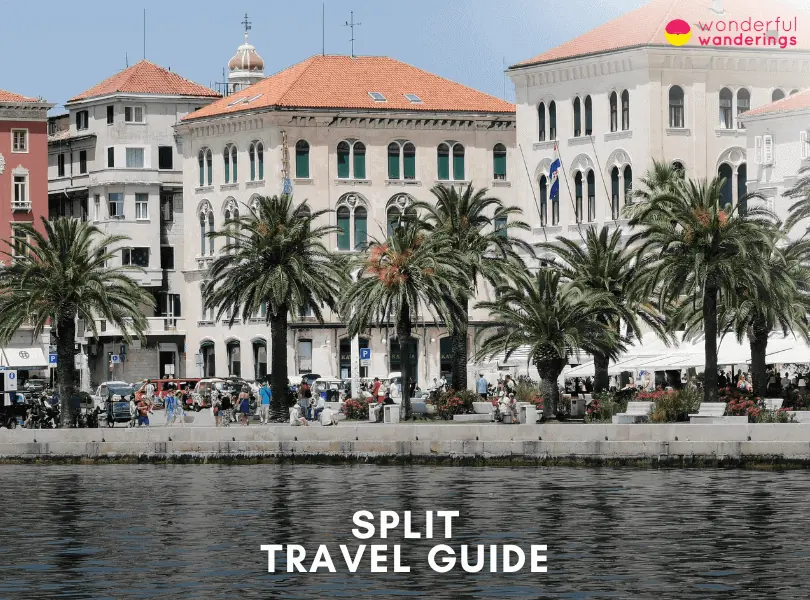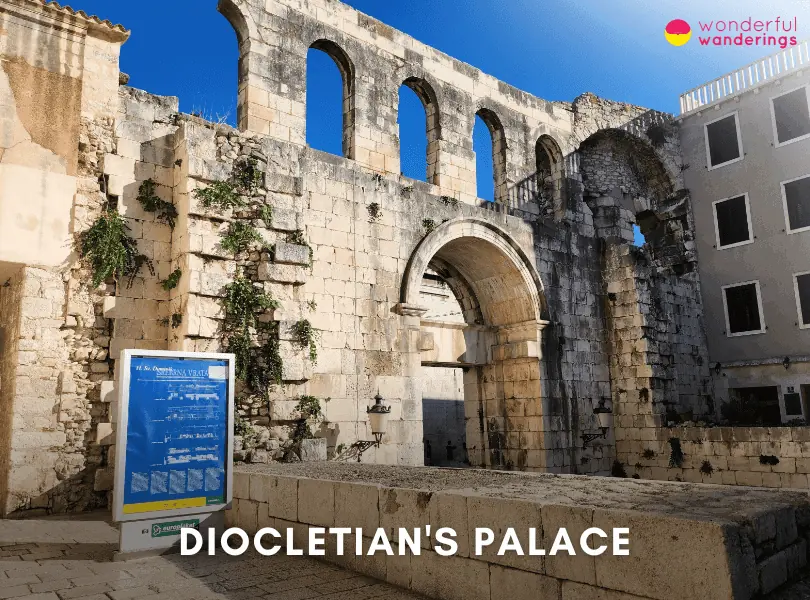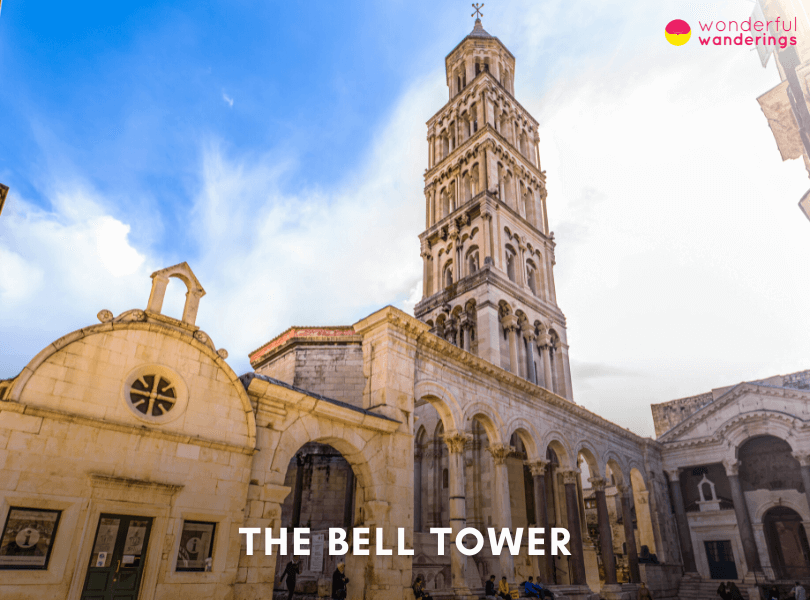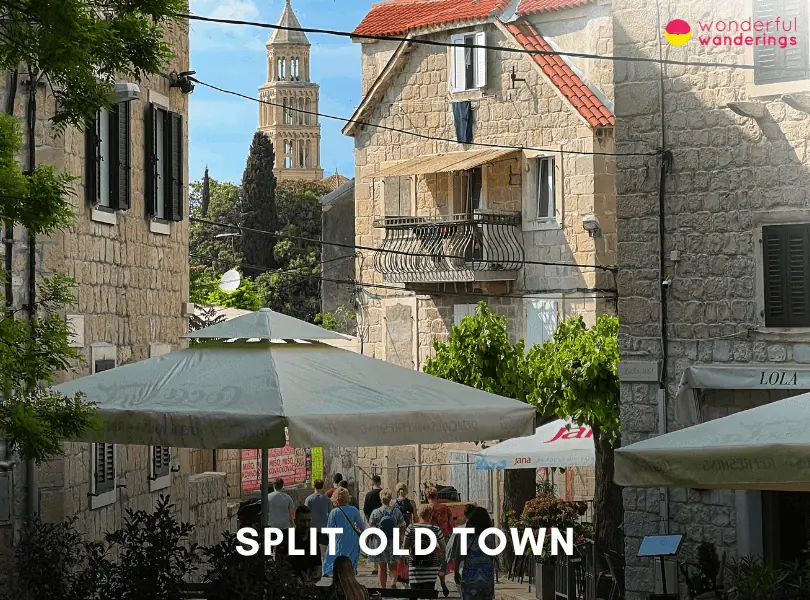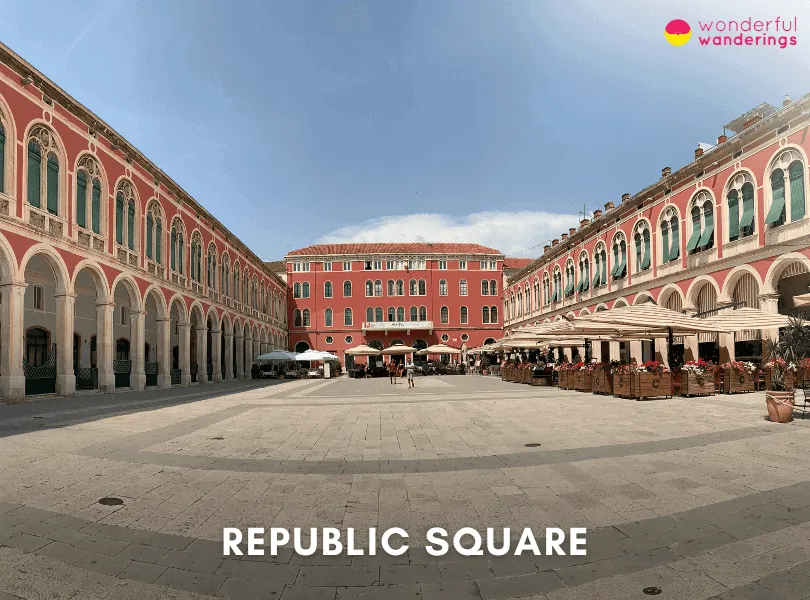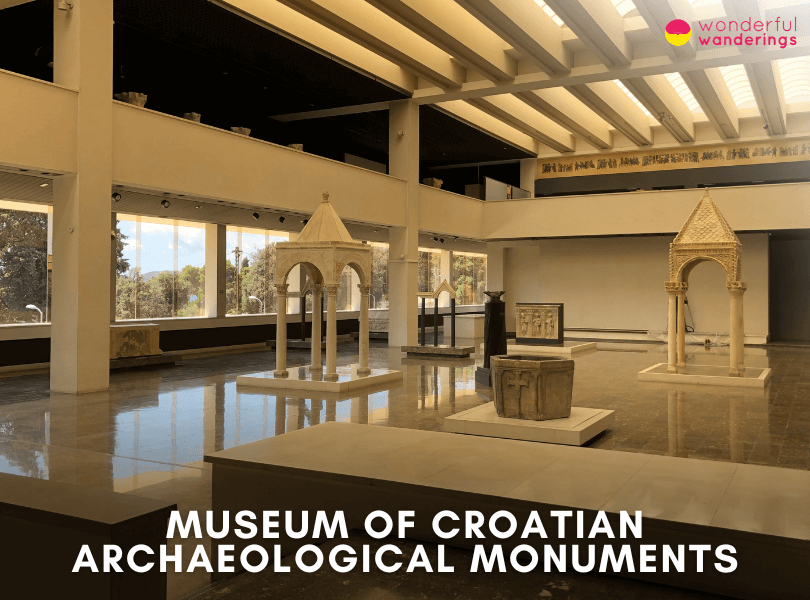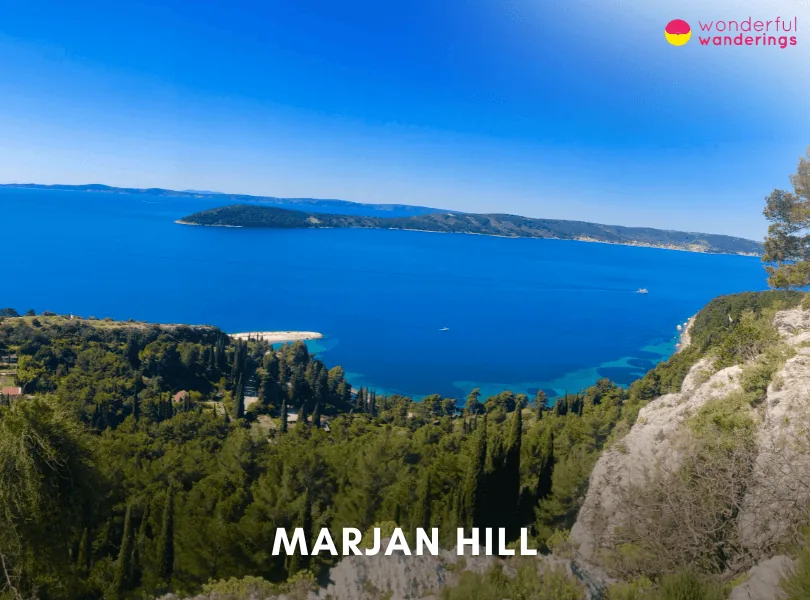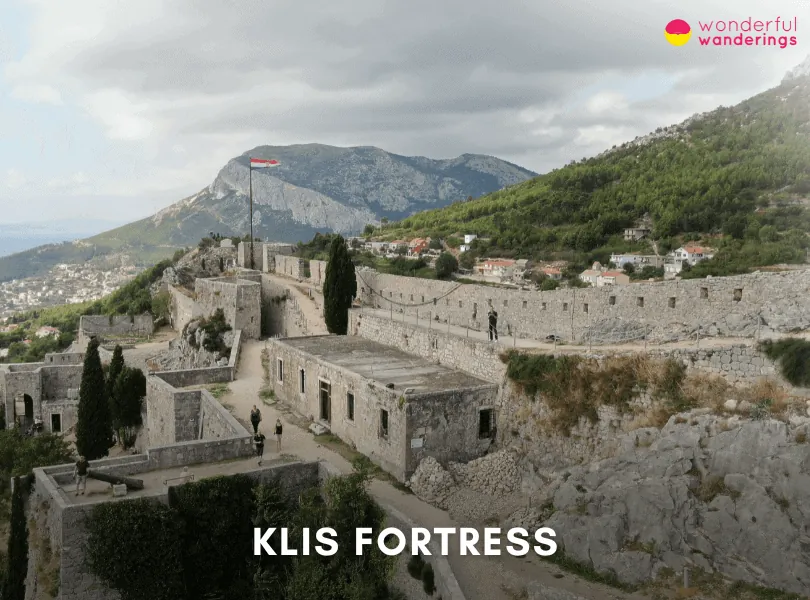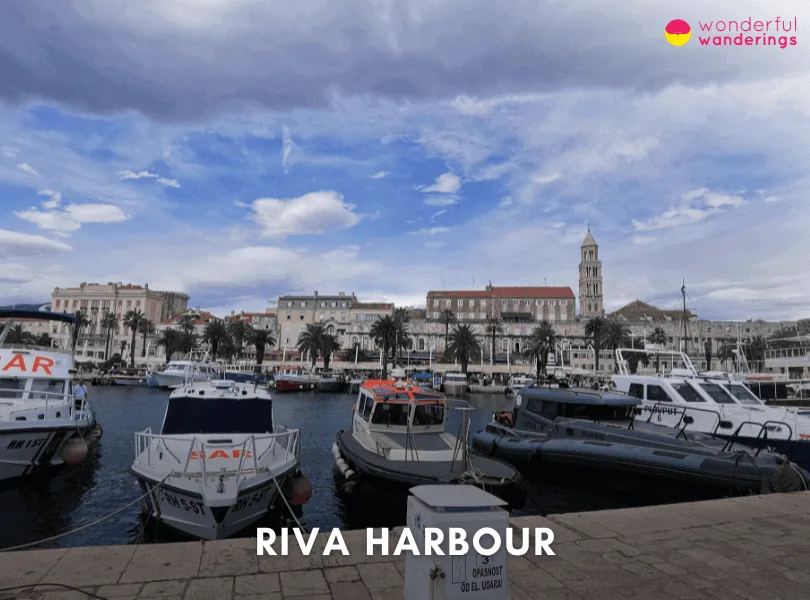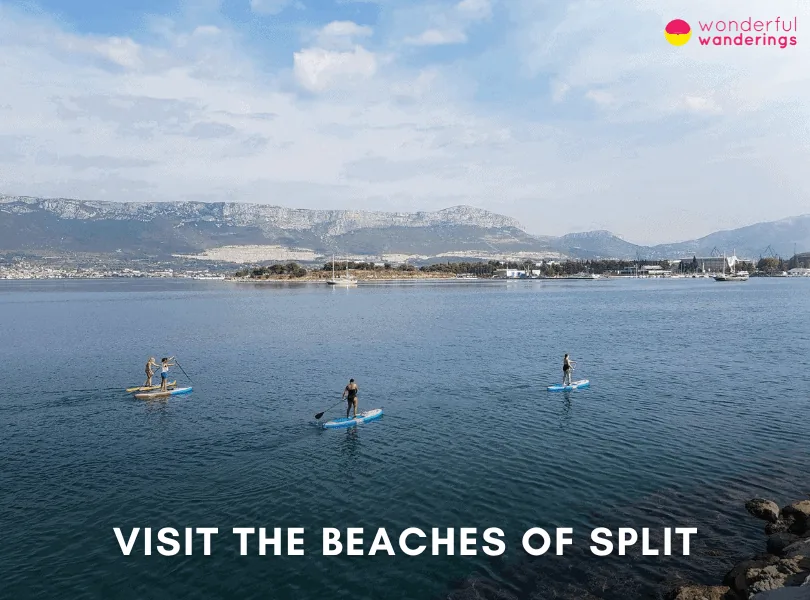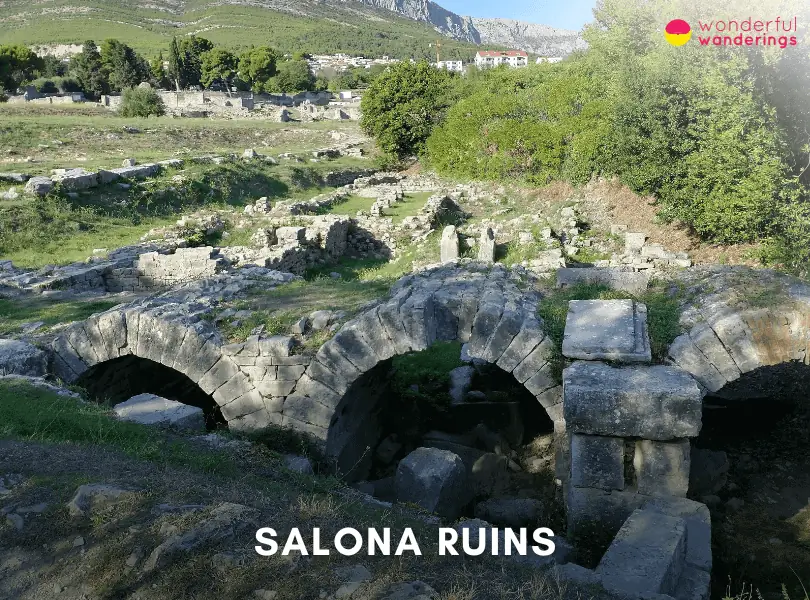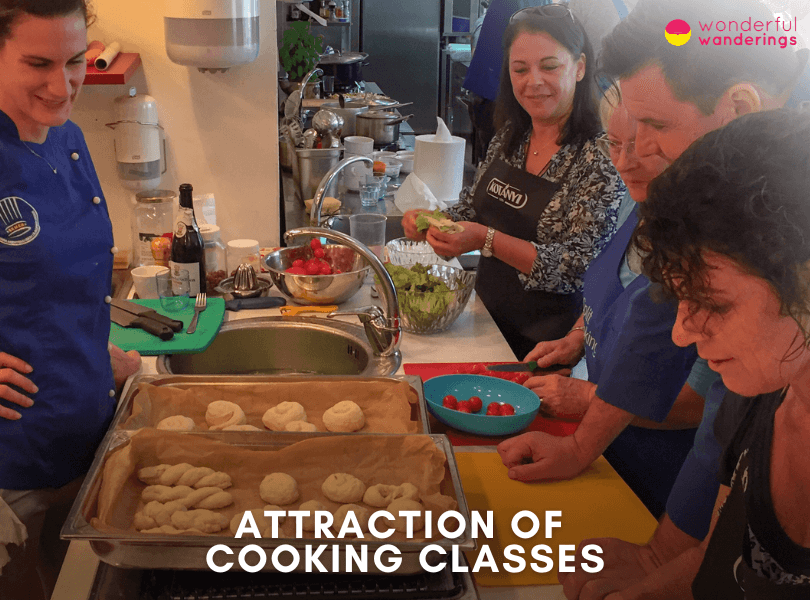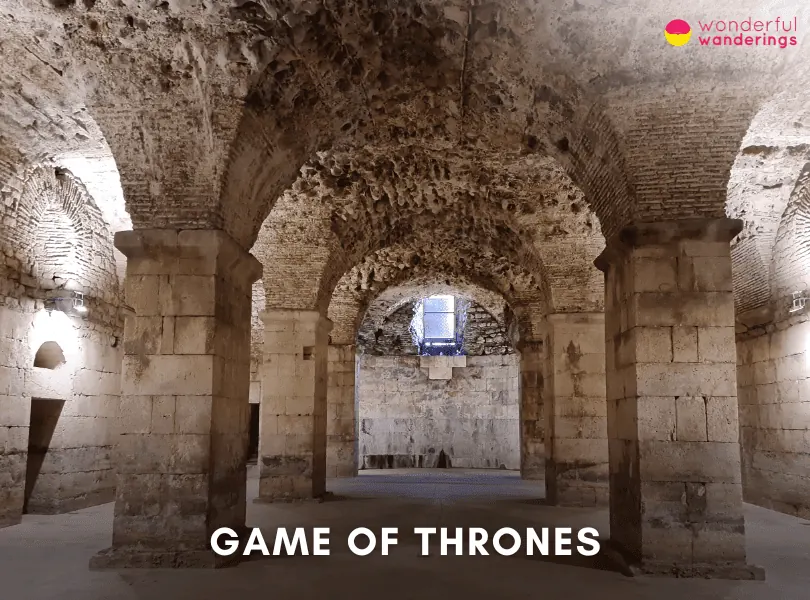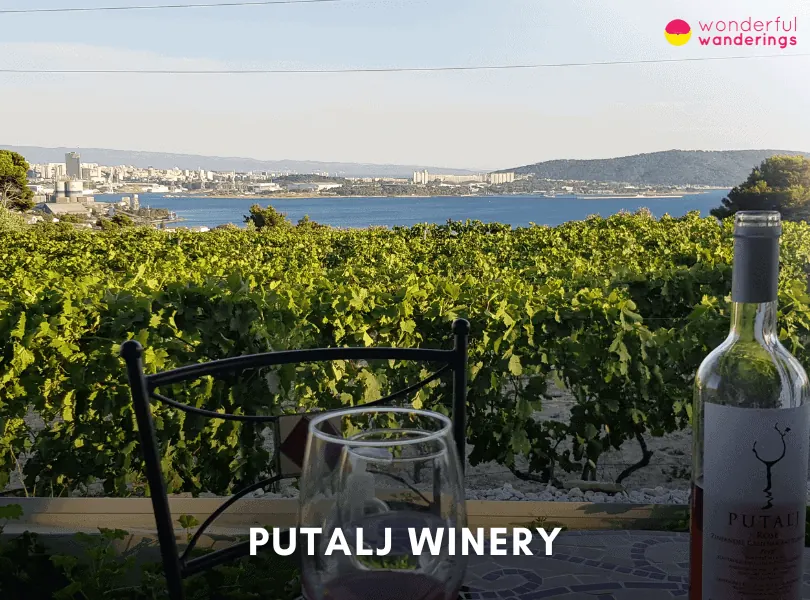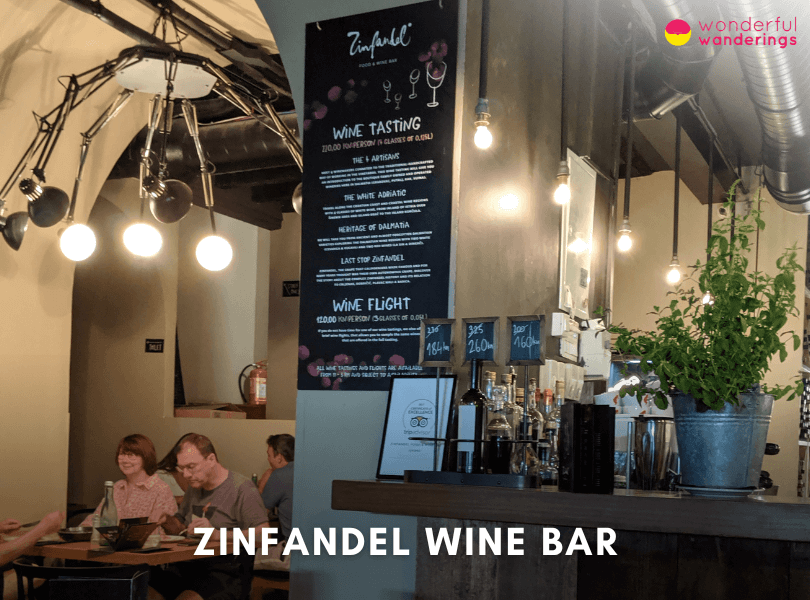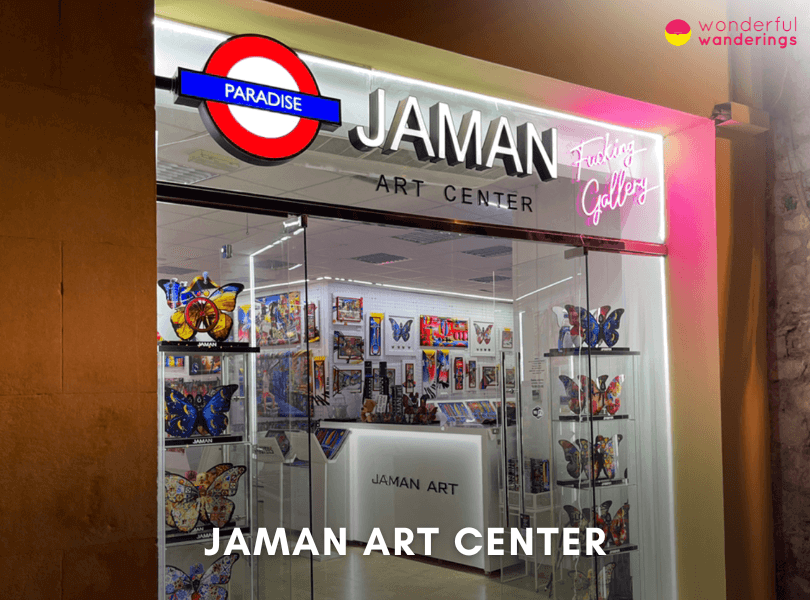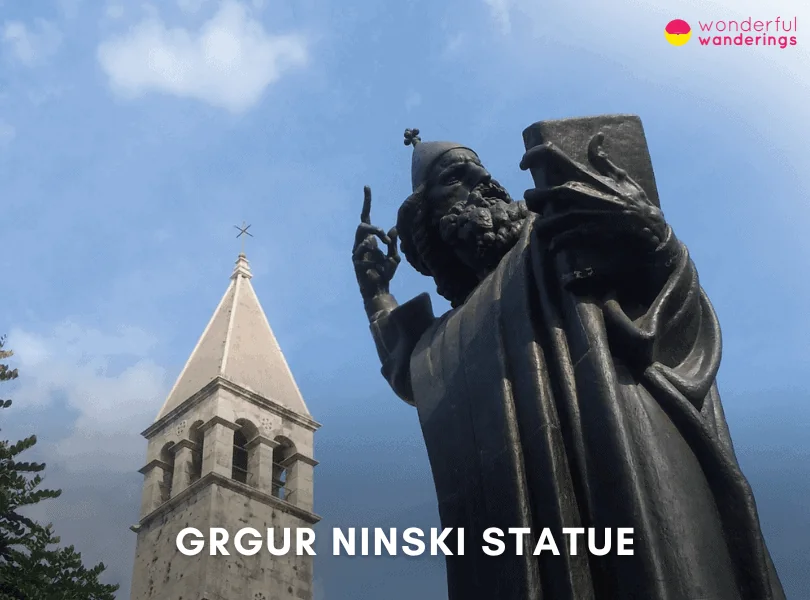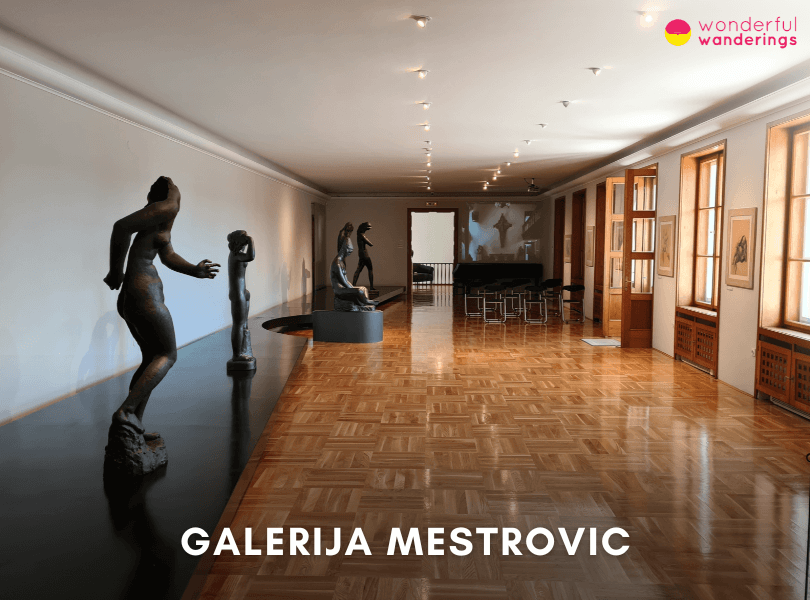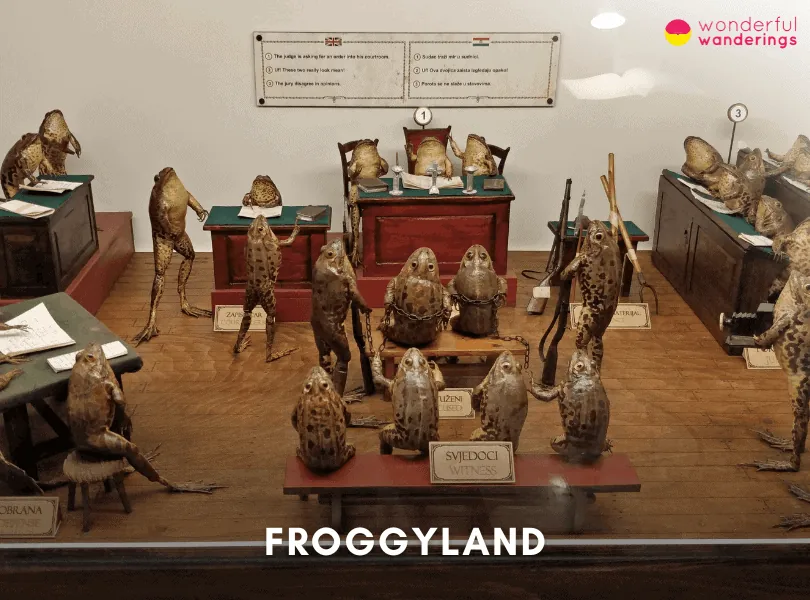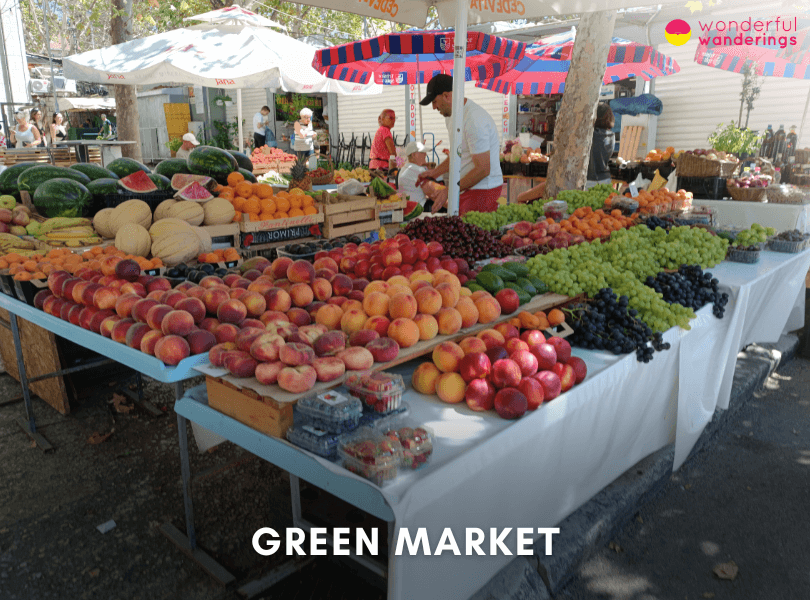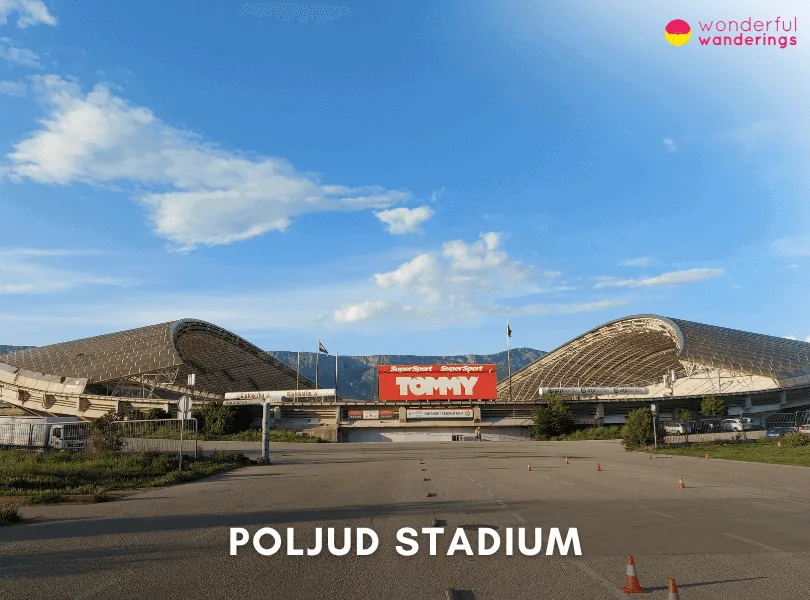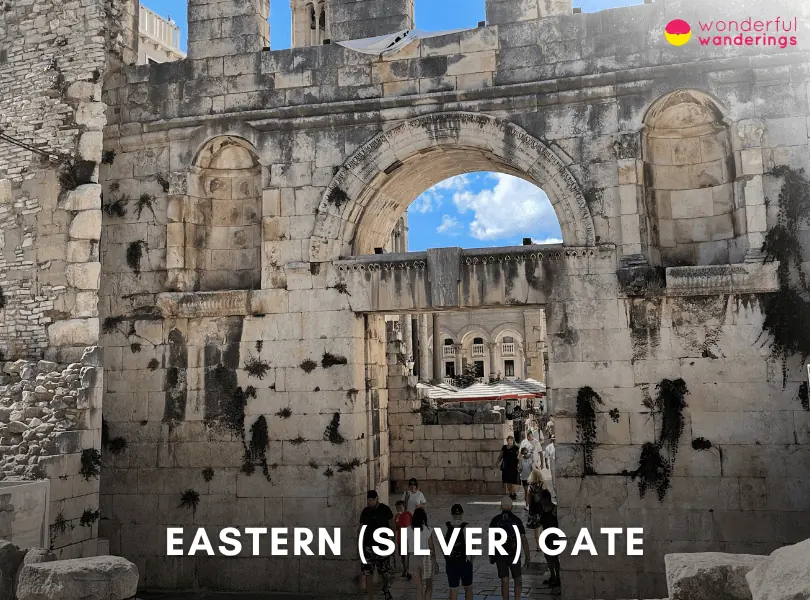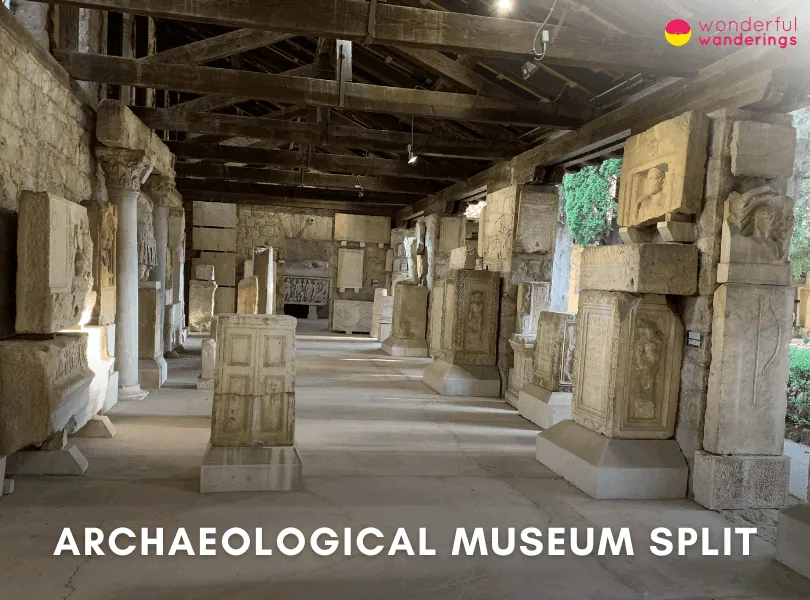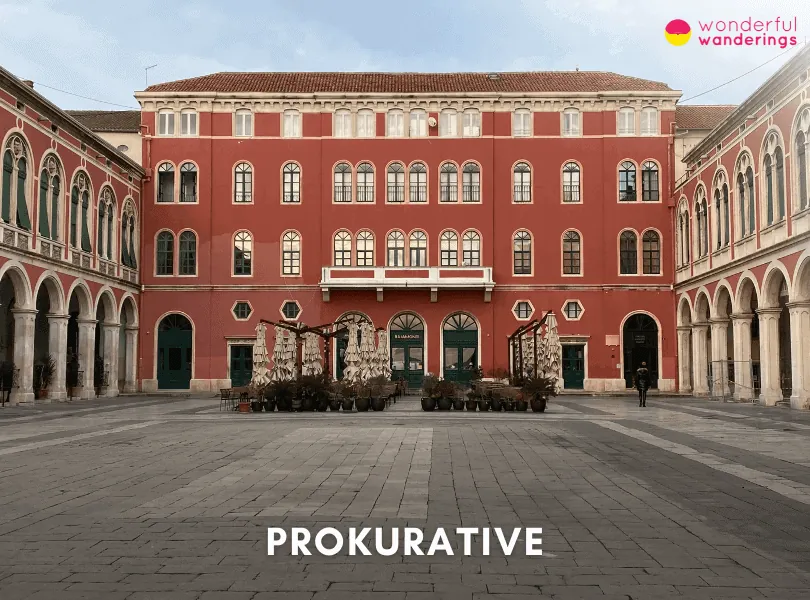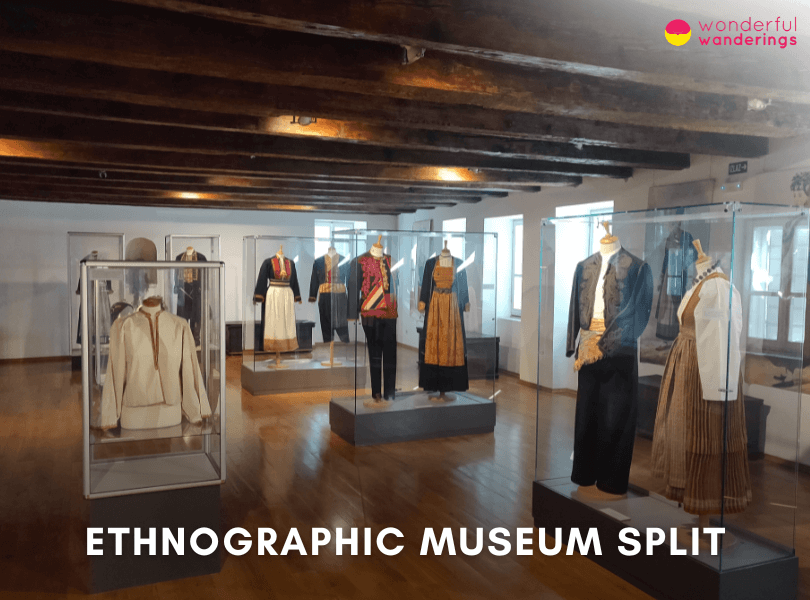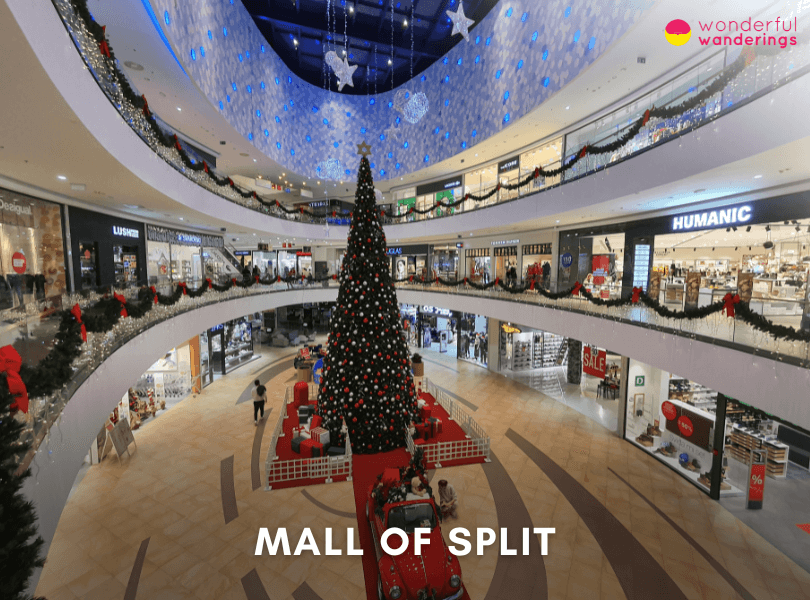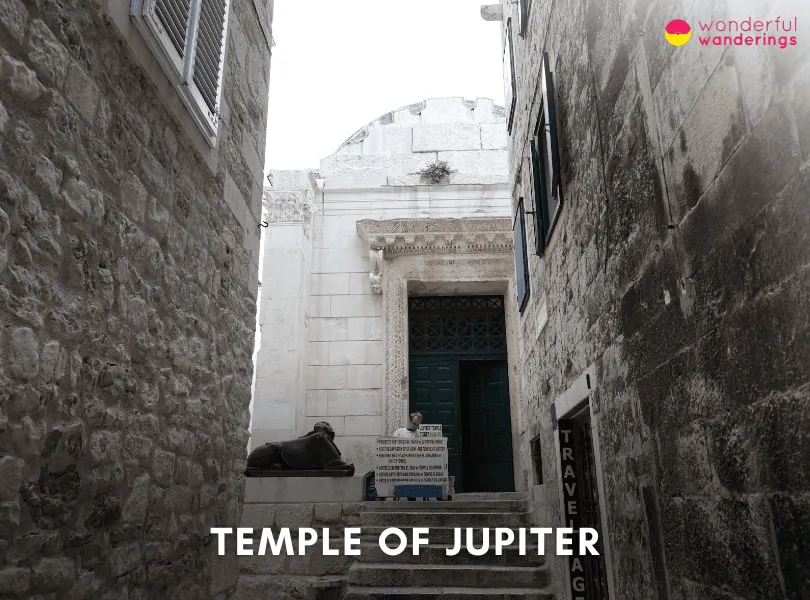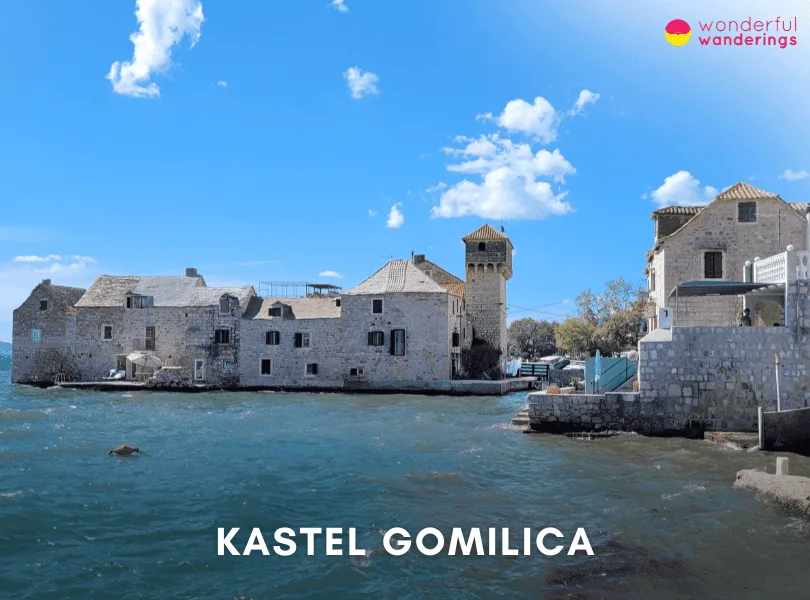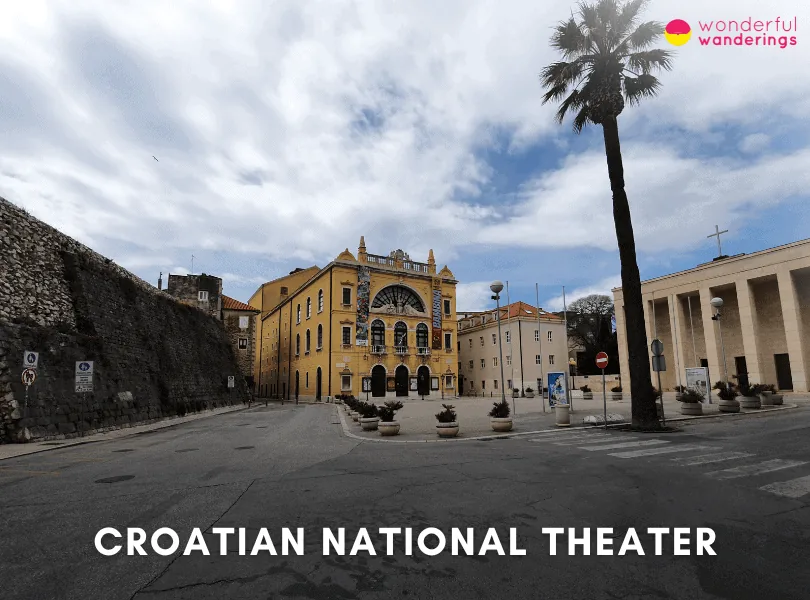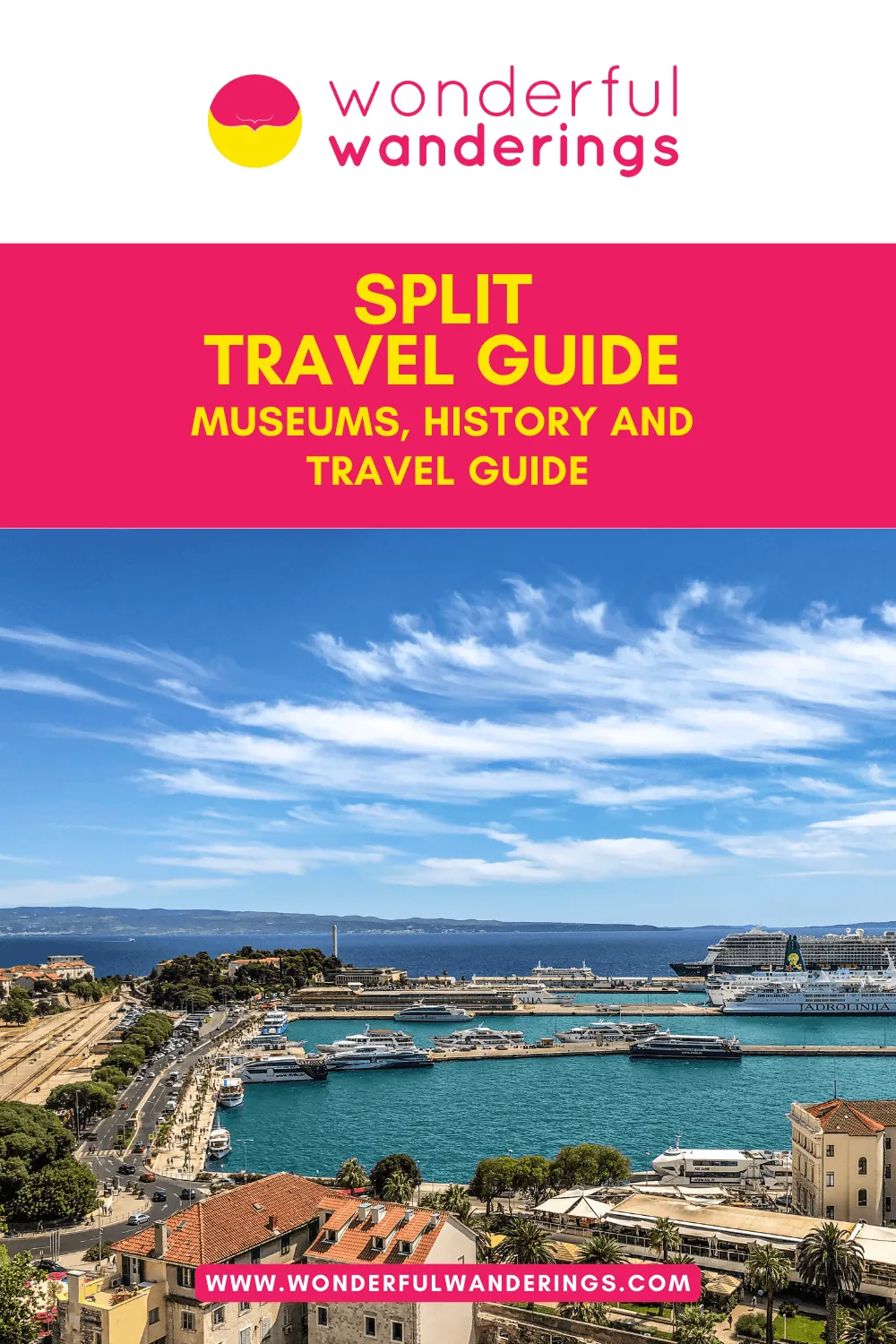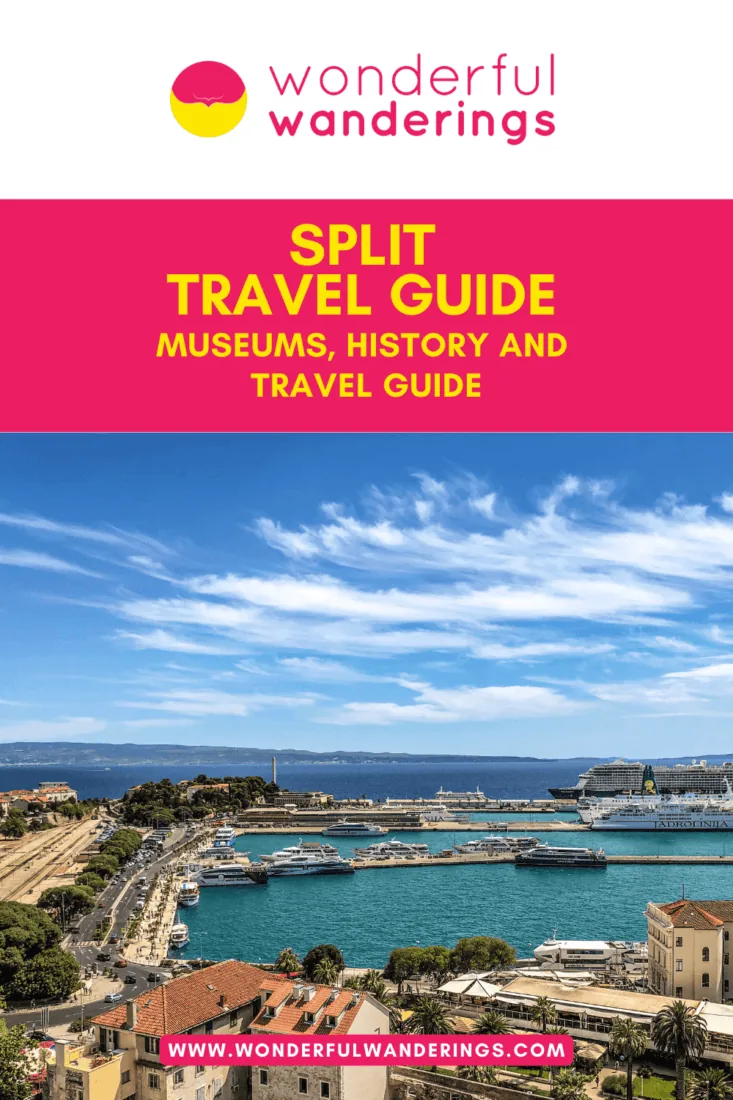Split is a historic seaside city on Croatia’s Dalmatian Coast, founded in the 3rd century BC. It developed within the 4th century Diocletian’s Palace, built for the Roman emperor’s retirement. This remarkably well-preserved palace forms the core of Split’s Old Town, which has been designated a UNESCO World Heritage Site. The total population of Split as of 2023 is 174,100 residents.
Split’s key site to explore in Split is the Diocletian’s Palace, with its narrow streets, imperial apartments and temples, basement chambers, Peristyle courtyard, Cathedral of Saint Domnius and four original gates. Visitors can enjoy swimming and stand-up paddleboarding at Split’s scenic beaches, trying fresh seafood and traditional dishes like pasticada beef stew, relaxing over Croatian wines, touring the Ivan Meštrović Gallery’s sculptures, catching summer music festivals in the Old Town squares or taking day trips to nearby islands and parks.
Split is affordable and provides an authentic local character. It can be comfortably seen in 2-3 days for first-time visitors. Historic architecture and ruins with lively street life, active nightlife, a relaxed coastal ambiance and proximity to the Adriatic islands make it one of Croatia’s best cities to visit. Split is located in the Central European Time zone. This time zone is one hour ahead of Coordinated Universal Time (UTC+1).
Listed below are the best things to do in Split
- Diocletian’s Palace. Diocletian’s Palace is an ancient Roman palace complex located in the historic center of Split, Croatia. It was built in the 4th century AD as a retirement residence for the Roman Emperor Diocletian. The palace covers over 30,000 square meters and incorporates Roman military architectural elements as well as features of a luxurious villa. It is situated along the coast, with fortified walls facing the harbor. Diocletian’s Palace is extremely well-preserved and forms the core of the old town of Split. The key sites within the palace walls include the Peristyle courtyard, underground substructures, the Cathedral of Saint Domnius, Jupiter’s Temple and the four gates named after metals.
- The Bell Tower. The Bell Tower is a tall structure that houses bells high above ground. Often part of churches and city halls, the towers allow the sound of bells to carry over greater distances. The most famous bell towers are found across Europe, especially in Italy. Prominent examples include the Leaning Tower of Pisa and St. Mark’s bell tower in Venice. Bell towers are typically imposing stone or brick buildings that visitors can climb, offering panoramic views from their heights. Even towers no longer in use hold architectural and historical value. Visitors can appreciate the towers’ engineering, learn their history and enjoy the resonant sound of bells ringing over the city.
- Split Old Town. Split Old Town is located in central Split, Croatia and is a UNESCO World Heritage site. It contains well-preserved ancient Roman ruins and medieval architecture from when Roman Emperor Diocletian built his palace there in the 3rd-4th centuries AD. The Peristyle courtyard, the Cathedral of St. Domnius, the Temple of Jupiter and the seaside promenade Riva are key sites. Wandering the cobblestone streets and alleys provides a glimpse into centuries of layered history as locals still inhabit and work in the old town.
- Republic Square. Republic Square is a large open square in Split, Croatia, located west of the Riva waterfront promenade. The square is surrounded on three sides by elaborate red neo-Renaissance buildings known as Prokurative. Locals often refer to the square as Prokurative. Prokurative was built in the 19th century during Austrian rule and was designed by a Venetian architect, closely resembling St. Mark’s Square in Venice. Republic Square hosts concerts, festivals and cultural events like the popular Split Summer Festival during the summer.
- Museum of Croatian Archaeological Monuments. The Museum of Croatian Archaeological Monuments, located in Split, Croatia, is dedicated to the medieval history and culture of the Croats. Founded in 1893, it displays an extensive collection of over 20,000 artifacts, including medieval jewelry, weapons, tools and stone monuments that were part of old Croatian churches. The museum’s collections of early medieval art and Latin inscriptions are the largest of their kind in Europe.
- Marjan Hill. Marjan Hill is a protected nature park and popular recreation spot located on a peninsula just west of Split, Croatia’s historic center. The densely forested hill has been an important part of Split since ancient times. It is known as the “lungs of Split”, providing a green escape from the city. Marjan Hill features scenic viewpoints, historic chapels, jogging trails, beaches and the Ivan Meštrović Gallery. Activities include hiking, cycling, swimming and rock climbing. The park offers beautiful panoramic views of Split and the surrounding islands and mountains.
- Klis Fortress. Klis Fortress is a historic medieval fortress located 15 kilometers (9 miles) Northeast of Split, Croatia. It was built in the 2nd century BC and controlled over the centuries by various rulers. The fortress features irregular stone structures spread over three sections. Visitors can freely explore the grounds, climb stairs and walk through narrow corridors. Highlights include Tower Oprah, St. Vid’s Church, the prince’s residence and a weapons collection.
- Stroll the Riva Harbour. Stroll the Riva Harbour, located 1.7 kilometers (1 mile) along the Adriatic Sea in Split, Croatia. Lined with palm trees, cafes, restaurants and shops, the pedestrian-only Riva serves as the hub of activity in Split. Locals and tourists flock to the Riva to stroll along the waterfront, relax at outdoor cafes and take in views of the ancient Diocletian’s Palace across the harbor.
- Visit the beaches of Split (Kasuni Beach, Žnjan City Beach, Bene Beach) for Stand-Up Paddleboarding. Visit the beaches of Split (Kasuni Beach, Žnjan City Beach, Bene Beach) for Stand-Up Paddleboarding. These beaches have calm, clear waters perfect for paddleboarding. Žnjan Beach is located southeast of the city center and has over 1 kilometer (0.6 miles) of pebbled coastline. It has shallow waters ideal for SUP, especially for beginners. Rentals, lessons, cafes and restaurants are right on Žnjan Beach. Kašuni Beach is in a picturesque bay below Marjan Hill, surrounded by forests and cliffs. Its scenic setting and calm cove make it excellent for paddleboarding. Rentals and lessons are available at Kašuni. Bene Beach is on the Marjan peninsula and is ideal for SUP, it is surrounded by pine trees that provide ample shade. Rentals are available right on Bene Beach.
- Salona Ruins. The ancient Roman ruins of Salona Ruins of the Ancient Roman is located near Split in Solin, Croatia. Salona was founded in the 3rd century BC and was the capital of the Roman province of Dalmatia. The city had over 60,000 inhabitants. Though partially destroyed by Slavic invasions in the 7th century AD, remarkably well-preserved ruins remain at the archaeological site. Visitors can explore sprawling ruins, including early Christian basilicas, ornate sarcophagi, public baths and an impressive amphitheater that could hold 18,000 spectators.
- Attraction of Cooking Class. The cooking class is attractive because it offers hands-on cooking classes where visitors can learn to make traditional dishes from Split. Popular options are held right in Diocletian’s Palace or along the Riva promenade. Participants shop at local markets for ingredients, then prepare a Croatian meal under a chef’s guidance. Typical dishes feature seafood, olive oil and Mediterranean herbs. Operators include the Split Cooking Class, Cucina Mare, Eat in Split and Secret Dalmatia. Classes run 3-4 hours and cost €100 ($109, £87) per person. They provide insight into Croatia’s culinary heritage and hands-on cooking experience.
1. Diocletian’s Palace
Diocletian’s Palace is an ancient palace complex located in the historic center of Split, Croatia. It was built in the 4th century AD as a retirement residence for Roman Emperor Diocletian. The palace covers over 30,000 square meters and is located along the sea coast, with walls facing the harbor. The exact address is Obala hrvatskog narodnog preporoda bb, 21000, Split. The palace is sometimes referred to as the Old Town of Split since the medieval city of Split developed within the palace complex.
Diocletian’s Palace is a remarkable example of Roman architecture and one of the most significant monuments on the Croatian coast. It is well-preserved and forms the historical core of Split. Visitors to Diocletian’s Palace can explore the narrow streets and passageways within the palace walls. Key sites include the Peristyle courtyard, the substructures’ underground basements, the Cathedral of Saint Domnius (originally Diocletian’s mausoleum), Jupiter’s Temple and the four palace gates (Golden, Silver, Iron and Bronze Gates).
There is no admission fee to walk the palace complex, but fees to enter the substructures or basements of the Cathedral of Saint Domnius and Jupiter’s Temple and to climb the cathedral bell tower. The easiest way to reach Diocletian’s Palace is to take a bus or taxi to the old town area of Split. The palace cannot be missed, as it comprises the city’s historic core. Split has an international airport, ferry connections by sea and is serviced by trains.
2. The Bell Tower
The Bell Tower is an architectural structure designed to house bells high above the ground. Often part of churches, cathedrals and town halls, bell towers elevate the bells so their sound can ring out over greater distances. The most famous bell towers across Europe, especially in Italy, where majestic towers have been part of church architecture for over a thousand years. Prominent examples include the Leaning Tower of Pisa, the bell tower in St. Mark’s Square in Venice and the Notre Dame Cathedral bell towers in Paris.
The Bell Tower is a tall, imposing stone or brick building with bells in an upper chamber or belfry. The bells are mounted so they can swing freely to ring when struck by a clapper. Some towers house multiple bells that can even be played melodically. Many bell towers can be climbed by visitors, offering panoramic views from their heights across urban skylines.
The towers allow the sound to carry farther than ground level and their height makes them symbols of civic power and prestige. Even bell towers that no longer function remain valuable as architectural and historical landmarks. Visitors to bell towers can admire the architecture and engineering, learn about their history, climb to the top for scenic vistas and appreciate the resonant sound of bells ringing over the city.
3. Split Old Town
Split Old Town is located in the center of Split, Croatia, along the Dalmatian coast; known as Diocletian’s Palace, Split Old Town is a UNESCO World Heritage site that contains well-preserved ruins dating back to Roman times in the 3rd and 4th centuries AD. Roman Emperor Diocletian had the palace complex built as his retirement residence during 295-305 AD. The locals moved into the abandoned palace structures, which organically developed into a medieval town after the fall of the Roman Empire.
Split Old Town is unique in that it is an active town that people still inhabit, work and visit while retaining its ancient Roman ruins and medieval architecture. Key sites for visitors include the Peristyle courtyard, Cathedral of St. Domnius, crypts, Temple of Jupiter and the narrow “Let Me Pass” street. The main promenade called the Riva, runs along the seafront, lined with palm trees, cafes and harbor views. Wandering the atmospheric cobblestone streets, alleys and small squares gives a glimpse into centuries of layered history. Split Old Town can be visited at any time for free, though select attractions like the cathedral bell tower require paid admission. It appeals to visitors of all ages interested in history, ancient ruins, medieval architecture and experiencing the lived-in nostalgia of a Roman town.
4. Republic Square
Republic Square (Trg Republike) is a large open square located west of Split’s famous Riva waterfront promenade. The square is surrounded on three sides by an elaborate red neo-Renaissance structure called Prokurative. Locals often refer to Republic Square as simply Prokurative after this surrounding architecture. Prokurative was constructed in the 19th century during the Austrian Empire’s control over Dalmatia and was designed by an architect from Venice. The design was largely inspired by architecture in Italy during that period and closely resembles St. Mark’s Square in Venice. Republic Square buzzes with activity during the summer months. The square’s open layout and seaside location make it an excellent venue for concerts, festivals and other cultural events. The most popular event is the Split Summer Festival, an annual music festival featuring classical music, opera, drama and folk performances. Visitors to Republic Square can sip coffee or cocktails at one of the many cafes lining the square, shop at the surrounding stores or simply sit and enjoy the energetic atmosphere and lovely harbor views. The square can be easily accessed by foot from Split’s Old Town area and other tourist sites.
5. Museum of Croatian Archaeological Monuments
The Museum of Croatian Archaeological Monuments is located at Meštrovićevo šetalište 18 in the city of Split, Croatia. It is the only museum in the country dedicated to researching and presenting the cultural artifacts and history of the medieval Croats, particularly from the 7th to 15th centuries and the period of the early Croatian state from the 9th to 12th centuries. The museum was founded in Knin in 1893 and moved to its current purpose-built facility in Split in 1976. The museum displays an extensive collection of over 20,000 artifacts, including medieval jewelry, weapons, tools and stone monuments and sculptures that were once part of old Croatian church interiors. The museum’s collection of early medieval wicker, clay figurines and Latin epigraphic monuments is the largest of its kind in Europe. Visitors can view the permanent exhibitions showcasing these collections as well as temporary rotating exhibitions. The museum is best suited for adults and students interested in medieval history and archaeology. Admission to the museum is free. The museum can be reached by public bus number 12 from downtown Split.
6. Marjan Hill
Marjan Hill is a protected nature park and popular recreation area located on a peninsula just west of Split’s historic center and Diocletian’s Palace. The densely forested hill is surrounded by the city and sea, giving it a unique setting. Marjan Hill has always been an important spot for local life in Split, dating back to when the ancient Greeks had settlements there. In the 3rd century AD, Roman Emperor Diocletian designated parts of Marjan as parkland for the residents of his Palace. Today, Marjan Hill is still known as “the lungs of Split”, providing a green oasis and escape from the bustling city. The park covers over 300 hectares and features jogging trails, scenic lookouts, tiny old chapels and beaches along its coast.
Popular activities on Marjan Hill include hiking, running, cycling, swimming, sunbathing, picnicking and rock climbing. The main entrance is located in the Varoš neighborhood, just a 10-15 minute walk west along the Riva waterfront promenade from the historic center. Visitors can climb the steep Marjanske Stube steps to the first scenic viewpoint. Other attractions include St. Nicholas Church from the 13th century, the Marjan Hill summit viewpoint marked by a giant Croatian flag and the Ivan Meštrović Gallery dedicated to Croatia’s most renowned modern sculptor. The hill’s south side features seaside attractions like Kašjuni Beach and the popular Bene Beach. Marjan Hill offers magnificent panoramic views of Split and the surrounding islands and mountains. It is an ideal place for families, nature lovers and those looking to escape the bustle of the city. Entry to Marjan Hill is free and open to the public year-round.
7. Klis Fortress
Klis Fortress is a medieval fortress located in the village of Klis, about 15 kilometers (9 miles) Northeast of Split, Croatia. It sits on a steep limestone cliff between the Mosor and Kozjak mountains, providing excellent defensive capabilities as well as stunning views of the surrounding landscape. Klis Fortress has a long and turbulent history spanning over 2000 years. It was originally built as a small stronghold by the Illyrian tribe Dalmatae in the 2nd century BC. Over the centuries, various rulers expanded and controlled it, including the Romans, Byzantines, Croats, Hungarians, Venetians, Ottomans, Habsburgs, French and Austrians.
The fortress is spread out over three main sections enclosed by defensive walls. Visitors can freely explore the grounds, climbing up and down stone steps and winding through narrow corridors. Highlights include the medieval Tower Oprah, 15th century St. Vid’s Church, the former prince’s residence and an armory housing a weapons collection. The top of the fortress provides breathtaking panoramic views over Split and the surrounding islands. Game of Thrones fans may recognize parts of the fortress as it was used to depict the city of Meereen in the TV series.
Klis Fortress is open daily from 9 am to 5 pm between April and October and 9 am to 4 pm from November to March. Visitors can drive or take a bus from Split. The steep climb up to the fortress entrance can be strenuous, so wear good walking shoes. The lack of signage and guides makes this an ideal site for an independent, adventurous visit. The fortress appeals to visitors of all ages interested in history, architecture or Game of Thrones.
8. Stroll the Riva Harbour
Stroll the Riva Harbour, which is located along the waterfront of Split, Croatia. It spans 1.7 kilometers (1 mile) along the shores of the Adriatic Sea, providing spectacular views of the harbor and nearby islands. The full address is Obala hrvatskog narodnog preporoda, 21000, Split, Croatia. The Riva Harbour is sometimes referred to as the Riva Waterfront or Split Riva.
Visitors to the Riva Harbour can go for a stroll, shop at the various boutiques, relax at one of the many cafes or restaurants or take photos of the harbor and the impressive views of the Adriatic Sea. It is a great place to observe daily life in Split, as fishermen bringing in their daily catch and sailors prepping their boats can often be seen along the docks. The Riva provides beautiful views of the ancient Diocletian’s Palace, which sits just across the harbor.
The Riva Harbour promenade is open 24/7 and is free to access. It is suitable for people of all ages and interests. The area can be reached on foot if you’re staying in central Split or via local buses that stop near the Riva. Exploring the scenic Riva Harbour is one of the top things to do in Split and offers an enjoyable seaside experience for all visitors.
9. Visit the beaches of Split (Kasuni Beach, Žnjan City Beach, Bene Beach)
Visit the beaches of Split (Kasuni Beach, Žnjan City Beach, Bene Beach) for Stand-Up Paddleboarding located on the Dalmatian Coast of the Adriatic Sea. It’s known for its stunning beaches, rich history and vibrant culture. Some of the most popular beaches in Split for stand-up paddleboarding (SUP) include Žnjan Beach, Kašuni Beach and Bene Beach. These beaches offer calm, clear waters perfect for paddling.
Žnjan Beach is located about 3 kilometers (1.8 miles) southeast of Split’s Old Town. It is one of the largest beaches in Split, with over 1 kilometer (0.6 miles) of pebbled coastline and beaches. The calm, shallow waters here are ideal for stand-up paddleboarding, especially for beginners. Rentals and lessons are available right on Žnjan Beach. Visitors can enjoy the beachside cafes, restaurants and bars.
Kašuni Beach is tucked into a bay below Marjan Hill, about 2.5 kilometers (1.5 miles) West of the city center. Its scenic setting, surrounded by forests and rocky cliffs, makes it a favorite of locals and tourists alike. The Calm Cove offers excellent SUP conditions, equipment rentals and lessons. Kašuni is more relaxed than some of Split’s busier beaches.
Bene Beach sits on the Marjan peninsula West of downtown Split. Its cove and calm waters are perfect for paddleboarding. Rentals are available onsite. Bene Beach is surrounded by a pine forest, providing ample shade. A restaurant and cafe offer refreshments after time on the water.
10. Salona Ruins
The ancient Roman ruins of Salona are located in Solin, Croatia, 5 kilometers (3.1 miles) Northeast of Split. Salona was founded in the 3rd century BC and served as the capital of the Roman province of Dalmatia. Salona had over 60,000 inhabitants, making it one of the largest cities in the Roman Empire. Though partially destroyed by Slavic invasions in the 7th century AD, the archaeological site contains remarkably well-preserved remnants of this once-great city.
Visitors can explore the sprawling ruins, including the remains of early Christian basilicas, ornate sarcophagi, public baths, an impressive amphitheater and more. The Tusculum Museum contains artifacts found at Salona and information about early excavations of the site. One of the most striking features is the 2nd-century amphitheater, which could hold up to 18,000 spectators for gladiator fights and other events. Though partly dismantled in later centuries, the elliptical outline of the amphitheater is still clearly visible.
Salona is ideal for visitors interested in ancient Roman and early Christian history. Kids may enjoy exploring the ruins, but some supervision is recommended as pathways are uneven. Sturdy shoes are advised. The Salona ruins are open year-round, though winter opening hours are reduced. Combined tickets with Split’s Archaeological Museum are available.
11. Attraction of Cooking Classes
The attraction of cooking classes is a popular activity for visitors to Spli. Several operators offer hands-on cooking classes where participants can learn to make traditional Dalmatian and Croatian dishes. Classes are typically held in central locations within Split itself.
One well-known option is the Split Cooking Class, operated by the Association of Chefs of the Mediterranean and Europe. Their classes take place right in the heart of historic Diocletian’s Palace. Participants get to shop for fresh ingredients at the Green Market and fish market in Split, then head to the cooking classroom to prepare a traditional Croatian meal. Dishes may include pasta, seafood risotto, stews featuring fresh fish, meat dishes cooked under a bell-like ‘peka’ oven and more. The 3-4 hour classes run daily, costing €100 ($109, £87) per person.
Cucina Mare, located on the Riva seaside promenade, has classes focused on teaching old family recipes of Croatian cuisine using seasonal ingredients. Participants learn fundamental culinary skills and dine on the meal they created. Classes feature hands-on participation and run about €90 ($98, £78).
Cooking classes allow visitors to gain insight into Croatia’s unique culinary traditions passed down through generations. Participants get hands-on experience preparing classic Dalmatian dishes featuring fresh seafood, Mediterranean herbs, olive oil and local wines. The classes provide an authentic taste of Croatian culture and cuisine. They suit adults, couples, families and teens interested in cooking and food. Advanced booking is usually required as they are popular activities in Split.
12. Game of Thrones
The coastal city of Split in southern Croatia is home to several iconic filming locations from the hit HBO series Game of Thrones. The most famous site is Diocletian’s Palace, the well-preserved ruins of a Roman palace built in the 4th century AD by the Roman emperor Diocletian. The sprawling palace complex, situated right in the heart of Split’s Old Town, doubles as the city of Meereen in the Game of Thrones universe. Several key scenes were filmed within the palace walls and underground cellars, including Daenerys’ throne room and the dungeon where she imprisoned her dragons. Visitors can explore the palace’s narrow marble streets and passageways, which were transformed into the streets of Meereen on the show.
Klis Fortress represented the city exterior of Meereen on the show. It was the site of the iconic scenes when Daenerys marches on the city, frees the slaves and crucifies the slave masters. Visitors can tour Klis Fortress, admire the sweeping coastal views and see the filming spots identified with photos and info. The fortress can be reached by car or local bus from Split.
13. Putalj Winery
Putalj Winery is a family-owned boutique winery located in Kaštel Sućurac, Croatia, outside the city of Split. The winery was founded in 2008 by Anton Kovač, who comes from a long line of winemakers in the area. He aimed to continue the family’s century-old winemaking tradition and produce high-quality wines from his vineyards and olive groves.
The winery offers organized tours and tastings by reservation only. The Winemaker’s Tour includes transportation from Split, a tour of the vineyard, production areas and barrel room, followed by a seated tasting paired with local foods like cheese, prosciutto and bread. You taste the wines right from the barrels and bottles while learning about winemaking and the history of the Kastela region from the passionate owner himself.
The tour costs €80 ($87, £70) per person and lasts about 4 hours. It is an intimate experience ideal for wine lovers looking to get off the beaten path. Advance booking is highly recommended as there are only small groups. Putalj Winery has earned rave reviews for providing one of the top wine-tasting experiences in Dalmatia.
14. Zinfandel Wine Bar
Zinfandel Wine Bar is a popular wine bar located in the heart of Split’s historic Diocletian’s Palace, on Marulićeva Street, halfway between the Pjaca and Voćni trg (Fruit Square). The wine bar opened in 2013 and has become renowned as one of the best places in Split to enjoy high-quality Croatian wines.
Zinfandel is named after the famous Zinfandel grape variety that originated in Croatia near Split before becoming popular in California wine regions. The wine bar boasts an impressive selection of over 100 bottled Croatian wines and 30 wines available by the glass. There is a focus on boutique and small-production wineries, with many of the wines coming directly from vineyards in Croatia. Zinfandel offers wines not typically found in regular shops and restaurants.
Zinfandel Wine Bar offers the perfect introduction to high-quality Croatian wines in a casual setting. It is great for wine enthusiasts eager to try indigenous varietals and grapes. The knowledgeable staff can provide tasting notes and help you navigate the extensive wine list. Zinfandel regularly hosts special tasting events focusing on specific wine regions. It is open daily from 8 am to midnight, making it easy to stop at any time for a glass or two. The central location makes it convenient for tourists and locals staying in the Old Town.
15. Jaman Art Center
Jaman Art Center is an art gallery located in Split, Croatia that showcases the pop art style paintings and sculptures of local artist Danijel Jaman. The gallery is situated in the city center at Dobrić 14, 21000 Split. Jaman Art Center is sometimes referred to as Jaman Gallery.
Jaman is known for his use of bright colors, graffiti styles and modern themes in his paintings. Many of his works incorporate 3D elements as well. The gallery features his original paintings, prints, smartphone cases and sculptures. His art often depicts modern pop culture icons like Mickey Mouse or incorporates ironic twists on classic artworks.
Visitors can browse and purchase Jaman’s artwork, including limited edition prints, posters and canvases. The gallery offers guided tours where you can learn about the stories and meaning behind each piece directly from the artist. Visitors may be able to speak with Jaman directly about his creative process and artistic vision. The gallery is located in the center of Old Town Split. It is easily accessible for visitors exploring the winding streets of the city. The gallery is open daily from 10 am to 11 pm, making it convenient to stop by. The gallery does not charge an admission fee; purchasing artwork is optional.
16. Grgur Ninski Statue
Grgur Ninski Statue is a large bronze monument located just outside the northern walls of Diocletian’s Palace in the old town of Split, Croatia. It depicts the 10th-century Croatian bishop Grgur Ninski, an important Croatian ecclesiastical and cultural history figure. Grgur Ninski was Bishop of Nin during a time when Catholic church services in the region were only conducted in Latin, which most Croatians could not understand. Ninski successfully campaigned for services to be held in Old Church Slavonic, the language used by the Slavic population. This allowed Christianity to spread more widely in the Croatian kingdom.
Visitors to Split make it a point to view and photograph the monumental sculpture. Many partake in the tradition of rubbing or touching Ninski’s big toe, which is said to bring good luck. The toe has been smoothed and polished to a shine from thousands of touches over the years.
Grgur Ninski Statue can be reached on foot by entering the palace complex through the Golden Gate off Kralja Tomislava Street. There is no admission fee to view the statue. It can be enjoyed by people of all ages and interests.
17. Galerija Mestrovic
Galerija Mestrovic is an art museum in Split, dedicated to the work of the famous 20th century Croatian sculptor Ivan Mestrovic. The museum is located on the southern slopes of the Marjan Hill peninsula, in the Meje district of Split, at Setaliste Ivana Mestrovica 46. It was originally built as Mestrovic’s family summer home and studio between 1931 and 1939, designed by the artist in a neoclassical style. Mestrovic donated the villa to the people of Croatia in 1952. It was converted into an art gallery and officially opened as the Ivan Mestrovic Gallery in 1955.
The permanent collection at Galerija Mestrovic contains 192 sculptures, 583 drawings, four paintings, 291 architectural plans and furniture designed by Mestrovic. His most famous works are carved in marble, bronze, wood and plaster, including masterpieces like Psyche, Job, Pietà and Adam and Eve. The thematic exhibition spaces include a central hall for marble works, the former dining room preserving the original interior, a hall for religious-themed sculptures and halls displaying works from different periods of Mestrovic’s career. There is an outdoor sculpture park and terraces overlooking the sea. Visitors can take a guided tour to learn more about Mestrovic and his works.
18. Froggyland
Froggyland is a unique taxidermy museum located in the center of Split at Kralja Tomislava 5. It contains a collection of 507 stuffed common frogs arranged into humorous scenes and tableaus depicting human life activities. This bizarre attraction is the life’s work of Hungarian taxidermist Ferenc Mere, who spent over ten years between 1910 and 1920 stuffing the frogs and positioning them using a special technique that left no external cuts or marks on their bodies. The scenes range from frogs playing sports or music, going to school, playing cards and more. Froggyland originally had over 1000 frogs, but only 507 have been preserved.
Visitors to Froggyland can stroll the museum and view the different frog scenes. There are 21 dioramas in total. Highlights include the circus scene, classroom and frogs playing various sports. Photography is not allowed inside, but you can take pictures at the entrance. The museum is suitable for all ages, both kids and adults, who want to see something weird and whimsical. Froggyland provides an unusual and lighthearted activity for tourists visiting Split.
19. Green Market
The Green Market (Pazar) is the bustling open-air produce market located just outside the eastern wall of Diocletian’s Palace in the heart of Split’s old town; known simply as Pazar, this sprawling market is the largest, most popular and most iconic food market in Split.
The market runs alongside the ancient palace walls, with vendors setting up stalls and displays daily to sell fresh fruits, vegetables, cheeses, cured meats, baked goods, flowers, herbs, olive oils, wines, artisanal products and freshly caught seafood. The Green Market is where locals do most of their regular grocery shopping. Haggling is common and adds to the spirited atmosphere. Vendors sell souvenirs, clothes, shoes, baked goods, household items and other non-perishable goods. But the focus remains on the seasonal, locally grown produce, meat, cheese and seafood that form the heart of Dalmatian cuisine.
Visitors can take home fresh ingredients to cook authentic dishes, sample foods like dried figs and artisanal cheeses and absorb the regional culture. Watching locals select vegetables or fishermen deliver the early morning catch provides an intimate look at daily life. The interactions between vendors and shoppers, many with longstanding relationships, reveal the community spirit.
20. Poljud Stadium
Poljud Stadium is a futuristic sporting arena located in the Poljud neighborhood of northern Split, about 1 kilometer (0.6 miles) North of the city center. It has a capacity of 35,000 spectators. This coastal stadium is the premier venue for football matches and cultural events in Split. Poljud Stadium was constructed in 1979 as one of the main venues to host the 1979 Mediterranean Games held in Split. The stadium was officially opened by the president of Yugoslavia at the time, Josip Broz Tito and originally had a capacity of 55,000 spectators. In the 1990s, seating was installed, which reduced the capacity to today’s 35,000.
The stadium’s signature feature is its eye-catching seashell-inspired architecture. It was designed by prominent Croatian architect Dr. Boris Magaš to resemble an open seashell gazing towards the sky. The roof structure consists of two sweeping concrete arches that span 205 meters across the east and west stands. This creates a very open and airy feel throughout the stadium.
Poljud Stadium regularly hosts major athletics meets, tournaments and track and field events, including the 1990 European Athletics Championships. Its capacity and facilities make it a prime concert venue during the summer months, hosting world-famous musicians and the Ultra Europe electronic music festival.
21. Eastern (Silver) Gate
Eastern (Silver) Gate is one of the original entrances into Diocletian’s Palace in Split, Croatia. It is located along the eastern wall of the palace, at the intersection of Hrvojeva and Krešimirova Streets, next to the Green Market. The gate’s original Roman name was Porta Orientalis, meaning “Eastern Gate”, but later became known as the Silver Gate. This gate served as a secondary entrance into the palace complex after the main Golden Gate to the north.
Visitors to Split can easily access the Silver Gate by walking from the Riva seaside promenade into the passages of Diocletian’s Palace. Take time to admire the gate’s ancient stonework and imagine the soldiers, servants and supplies that once passed through. The gate makes a good starting point to explore the palace complex. Walk east towards the Green Market or head west to reach the Peristyle Square in front of the cathedral. Getting a glimpse of the historic Silver Gate captures the spirit of strolling the pedestrian streets of Split’s Old Town.
22. Archaeological Museum Split
The Archaeological Museum in Split is located at Zrinsko Frankopanska 25 in the coastal city of Split, Croatia. With a history dating back to 1820, it is the oldest museum in Croatia. The museum contains 150,000 historical artifacts, offering a comprehensive overview of the region’s past. Significant collections cover the Greek colonization of the Adriatic, the Roman era when Split was part of the province of Dalmatia, early Christianity and medieval Croatia.
Visitors can walk to visit the collections in the lapidarium and appreciate the finely carved Roman portraits and family scenes. Inside the museum, artifacts are well-lit in glass display cases and interesting thematic exhibits tell the story of the region through the ages. Translated signage explains the significance of items. The museum offers an ideal activity for travelers interested in antiquities and history, especially as a complement to exploring Diocletian’s Palace.
The Archaeological Museum is open year-round, five days a week, with seasonal summer weekend hours. Guided group tours should be booked in advance via the museum website. There is a cafe inside for refreshments.
23. Prokurative
Prokurative, known as Republic Square, is a famous public plaza located in the historic core of Split, Croatia. It is situated just west of Diocletian’s Palace, the 4th-century AD Roman structure that now forms the old town center of Split. The large open square is surrounded on three sides by elegant arcaded buildings constructed in the late 19th and early 20th centuries.
Prokurative provides an ideal events venue in the center of Split. The square hosts concerts and other performances, especially during summer. Since the 1960s, it has been the site of the annual Split Music Festival, spotlighting pop and rock artists. Open-air cafés, restaurants and shops occupy the plaza’s grand buildings. The open southern edge of Prokurative offers beautiful vistas overlooking Split Harbor.
People strolling through Split’s Old Town should make sure to wander through Prokurative’s colonnades and admire the architecture. Grab a cafe table to soak in the atmosphere or watch street performers. The plaza offers a great vantage point to gaze out at the bustling harborfront Riva promenade. Prokurative is just a 5-minute walk from the Palace, so it perfectly combines with a self-guided walking tour of Diocletian’s Palace.
24. Ethnographic Museum Split
The Ethnographic Museum Split is located inside the walls of Diocletian’s Palace in Split, Croatia, at Severova 1. It was founded in 1910 and houses over 20,000 artifacts related to the cultural heritage of Dalmatia and the surrounding region. The museum’s extensive collections include traditional folk costumes, musical instruments, jewelry, weapons, tools and toys. Visitors can view reconstructed interiors showcasing furniture and daily objects from Split during the 19th and early 20th centuries. Highlights include ornate costumes with beautiful embroidery and lacework from the islands of Pag and Hvar. The museum is set within a Gothic building that was once Split’s town hall. An added highlight is access to the roof of the palace’s vestibule, which provides panoramic views over the city. The Ethnographic Museum Split offers an in-depth look at the history and traditions of Croatia’s Dalmatian Coast.
25. Mall of Split
The Mall of Split is a large shopping mall located at Josipa Jovića 93 in the east of Split, Croatia. With over 200 stores and 60,700 square meters of retail space, it is the largest shopping center in Dalmatia. Opened in 2016, the mall features major international fashion brands like Zara, Massimo Dutti and H&M alongside Croatian retailers. Other offerings include a supermarket, restaurants, a food court with outdoor seating, a movie theater and a casino. The building has a modern architectural design and amenities like free WiFi. Parking is available in a garage. Visitors can access the mall by car or public transit, as it is located near major roads and served by several bus routes. A free shuttle bus runs between the mall and Split’s ferry port. The Mall of Split provides shoppers with a wide selection of stores and entertainment options in a contemporary setting.
26. Temple of Jupiter
The Temple of Jupiter is an ancient Roman temple located in the western portion of Diocletian’s Palace at Ul, Split, Croatia. Kraj Svetog Ivana 2. It is known as Jupiter’s Temple and it was built between 295 and 305 AD, along with the palace for Emperor Diocletian, who dedicated it to Jupiter, the king of the gods in Roman mythology. The small rectangular temple is remarkably intact, including its barrel-vaulted ceiling decorated with carved stone coffers. A headless granite sphinx from Egypt stands guard at the entrance. In later centuries, the temple was converted into a Christian baptistery dedicated to St. John the Baptist. Highlights include medieval sarcophagi, a 13th-century baptismal font and a bronze statue of St. John by 20th-century Croatian sculptor Ivan Meštrović. The Temple of Jupiter stands out for its blend of Roman, early Christian and medieval architecture and art, spanning over 1,500 years of history.
27. Kastel Gomilica
Kastel Gomilica is one of seven historic coastal towns located in the Kastela municipality along the central Dalmatian coast of Croatia, about 8 kilometers (4.9 miles) Northwest of the city of Split. It is situated in Kaštela Bay, between the towns of Split and Trogir. Kastel Gomilica was established in the 16th century around a fortified Benedictine monastery built on a small islet called Gomilica. The fortified complex, known as Kaštilac, was constructed between 1529 and 1537 to protect the nuns and residents from Ottoman raids inside the walls of Kaštilac. The nuns built a Romanesque church called St. Kuzma and Damjan in the 12th century. Today, Kaštilac is one of the best-preserved old fortified towns in the Kastela area, featuring medieval architecture and stone streets. Visitors can walk along the old walls, see the historic church and explore the quaint alleys and squares. Kastel Gomilica has a waterfront promenade, beaches and marinas that attract tourists. The town is known for its summer music events and entertainment in the main square. Many cafes and restaurants can be found along the seaside. Kastel can be reached by local bus from Split’s main bus station. The historic fortified old town appeals to visitors interested in medieval architecture, history and charming coastal towns. Admission to walk and visit around Kastel Gomilica is free.
28. Croatian National Theater
Croatian National Theater, referred to by its Croatian abbreviation HNK Split, is a historic theater located in the city of Split, Croatia. The theater building is situated in the heart of Split on a central square called Trg Gaje Bulata. Constructed in 1893 during the Austro-Hungarian era, the ornate theater was built in a neoclassical style by two local Split architects, Emilio Vecchietti and Ante Bezić. It is owned by the city of Split and is one of the oldest functioning theaters in Dalmatia. The 1000-seat theater originally staged performances by traveling theater troupes and held its first resident professional company in 1920. In 1970, the theater building was badly damaged by fire but later reconstructed. Today, HNK Split continues to be a center of culture in Dalmatia, hosting around 300 theatrical, opera and ballet performances each year. Visitors can tour the elaborate interior and see productions at the theater year-round. Attending performances requires purchasing tickets, which can be bought at the box office or online. Prices vary depending on the show. People interested in the arts, theater architecture and Croatian culture would appreciate visiting HNK Split, located in central Split just steps from Diocletian’s Palace.
What are the best museums to visit in Split?
Listed below are the best museums to visit in Split.
- Archaeological Museum. The Archaeological Museum showcases various artifacts and monuments from ancient Greek and Roman times to the Middle Ages. This museum is dedicated to archaeology and history. It is located at Zrinsko-Frankopanska 25 in Split. The museum was founded in 1820 and contains over 150,000 artifacts in its collection. Some of the highlights include ceramic bowls and amphorae from the island of Hvar dating back to the 5th century BC, marble figurines and reliefs from Salona, intricate mosaics and a warrior helmet from the 4th century BC Graeco-Illyrian period. Roman-era sculptures, glassware, lamps, jewelry and a large collection of ancient coins exist. Many artifacts come from excavations at the nearby Roman settlement at Salona. Visitors can explore the museum exhibits chronologically in well-lit displays. The archaeological artifacts provide insight into Split’s ancient inhabitants’ daily lives and customs. General admission to the Archaeological Museum in Split costs €5 (€5, £4) per adult. There are reduced prices available for students and children.
- Split Ethnographic Museum. Split Ethnographic Museum offers insight into the cultural history and daily life of Split and the surrounding regions. This is an ethnographic museum dedicated to local culture and folklife. The museum is located at Iza Vestibula 4 within the imperial palace complex built by Roman Emperor Diocletian in the 4th century AD. The museum contains a vast collection of folk costumes, jewelry, tools, furniture, weapons, toys and other artifacts collected from Split, Dalmatia and other regions of Croatia. Visitors can view recreations of traditional homes and workshops with mannequins dressed in historic costumes. The museum has exhibits spanning the history from the 15th century to the 20th century. Visitors can climb up an ancient Roman staircase to reach the roof, which provides panoramic views over the Old Town and Split Harbor. General admission to the museum of Split Ethnographic Museum costs €2 ($2, £1) per adult. There are reduced prices available for students and children.
- Ivan Meštrović Gallery. Ivan Meštrović Gallery contains a large collection of works by the famous 20th-century Croatian sculptor Ivan Meštrović. The museum is dedicated to the life and works of a single artist. It is located at Šetalište Ivana Meštrovića 46 in Split. It contains over 90 of his bronze, marble and wood sculptures, showcasing religious, portrait and figurative themes. Some highlights include his Well of Life fountain, statues depicting women in pleated robes and Job and Eve After the Fall. General admission to the Museum of Ivan Meštrović Gallery costs €5 (€5, £4) for adults, with reduced prices available for students and youth.
- Gallery of Fine Arts. The Gallery of Fine Arts in Split contains a broad collection of over 5000 works spanning 600 years. This is an art museum with both permanent and temporary exhibitions. It is located at Kralja Tomislava 15 in Split. The permanent exhibits include Croatian, Venetian and international art dating from the 14th century to contemporary pieces. Highlights include 15th-century sacred pieces, ornate 17th-century altarpieces, Croatian 19th-century portraiture and modern 20th-century paintings and sculptures. Some notable artists featured include Vittore Carpaccio, Federico Bencovich, Vlaho Bukovac, Emanuel Vidović, Ignjat Job and Ivan Meštrović. Guided tours may be arranged by appointment. General admission to the Gallery of Fine Arts museum costs €5 (€5, £4) per adult. There are reduced prices available for students and youth. Admission to temporary exhibitions may require separate tickets.
- Split City Museum. Split City Museum illustrates the long history of Split through a collection of artifacts, monuments, documents and more. This is a local history museum located inside Diocletian’s Palace at Papalićeva 1 in Split. The museum is housed in the Papalić Palace, a beautiful 15th-century Gothic-Renaissance building that once belonged to the noble Papalić family. The exhibits include statues, inscriptions, architectural fragments, drawings, photographs and weapons and armor dating from ancient Roman times to the 20th century. The museum occasionally hosts cultural events and educational workshops for visitors. Guided tours may be booked in advance. There is a cafe and gift shop on site. General admission to the museum costs €2 ($2, £1) for adults. There are reduced prices available for students and children.
What are the best things to do in Split with kids?
Listed below are the best things to do in Split with Kids.
- Explore Diocletian’s Palace. Exploring the Diocletian’s Palace is one of the top things to do in Split, Croatia. Families with toddlers will love wandering through the maze of cobblestone streets and soaking in the ancient surroundings. Older kids will enjoy exploring the well-preserved Roman architecture, such as the palace halls, basement, chambers and Temple of Jupiter. Game of Thrones fans will recognize it as an iconic filming location. Visitors can take in the sights by simply wandering the streets or visiting ticketed areas like the cathedral and bell tower, with admission prices starting at €4 ($5, £3) per person and free for children under 6 or 7.
- Visit Marjan Hill Park. Visit Marjan Hill Park is a must-visit outdoor attraction in Split, Croatia, with something for visitors of all ages to enjoy. This large nature park covers over 3 square miles of trails, beaches, playgrounds and scenic viewpoints overlooking Split and the sea. Families with toddlers will love playing at the playgrounds and swimming at the beaches tucked into coastal coves. Older kids can hike or bike along miles of trails winding through pine forests or explore historic sites like medieval chapels. Marjan Hill Park offers free entry and a variety of outdoor activities, from hiking to swimming and is an excellent choice for a fun day out with kids, families and toddlers.
- Go to Bacvice. Beach Go to Bacvice Beach is a perfect spot, with sandy shores and shallow, clear waters ideal for families with toddlers. Toddlers will love frolicking in the gentle waves. Older kids can swim or play beach games and parents can pack a picnic, toys, an umbrella and towels. Parents can relax while the kids enjoy beach time with facilities like cafes and promenades alongside the beach.
- See the Froggyland Museum. See the Froggyland Museum, which houses over 500 stuffed frog dioramas showing scenes of daily life. Kids will be fascinated and entertained by the frog tableaux depicting frogs as schoolchildren, performers, athletes and more. The museum is small but offers an unusual experience as kids notice new details in each display. Parents can use it as a learning opportunity, discussing the stories in each scene. The museum’s founder spent years building this collection that celebrates creativity and skill. The Froggyland Museum is a hidden attraction that makes for a memorable family activity.
What are the best activities for a business traveler in Split?
Listed below are the best activities for a business traveler in Split.
- Stroll along the Riva Promenade. Stroll along the Riva is Split Promenade that runs along the waterfront. It offers beautiful views of the Adriatic Sea and the bustling port where large ships and yachts dock. The promenade is lined with palm trees and features many benches, restaurants, cafes and bars. It is the perfect place for a business traveler to go for a relaxing stroll after a day of conferences to unwind while enjoying the seaside ambiance. Travelers can easily spend an hour strolling up and down the promenade, stopping to grab a drink or bite to eat while soaking in the views. There is no cost to walk along the Riva.
- Visit the Ivan Meštrović Gallery. Ivan Meštrović Gallery is an art museum dedicated to the works of Croatia’s most significant 20th-century sculptor, Ivan Meštrović. It is housed in a beautiful building designed by Meštrović in the 1930s. The gallery features a wide collection of his sculptures, drawings and architectural plans. For any business traveler interested in art and culture, this gallery is a must-visit attraction for an outing after conferences and meetings. The Ivan Meštrović Gallery is located at Šetalište Ivana Meštrovića 46 in Split. The gallery makes for a nice 1-2 hour cultural excursion after a day of business appointments and is open from Tuesday to Sunday, 9 am to 7 pm in the summer season.
- Dine at Restaurant Zinfandel. Dine at Restaurant Zinfandel is a popular upscale restaurant located right in the center of Diocletian’s Palace. It is known for its delicious contemporary Dalmatian cuisine and extensive Croatian wine list. The menu features fresh seafood, pasta, risotto and a variety of meat dishes, all expertly prepared and presented. The atmosphere is elegant yet relaxed, perfect for a team dinner or client outing after a full day of meetings.
- Relax at Jakov Beach Club. Relax at Jacov Beach Club, take a break from business meetings and appointments and head to Jakov Beach Club. This stylish beach club is located in a small bay in the coastal town of Slatine, just a 10-minute taxi ride from Split’s city center. It has a laidback vibe, with lounge chairs lining the pebbly beach and a restaurant/bar on site. Visitors can go for a swim, enjoy a massage or simply unwind on a lounge chair beneath the umbrellas. The restaurant serves up fresh seafood, salads and Mediterranean cuisine. It is the perfect place to escape from the business meetings and bustle of the city center. Business travelers could easily spend 2-3 hours here relaxing with a book, swimming and grabbing a leisurely bite to eat for a nice change of pace.
Where is Split?
Split is located on the Adriatic coast in southern Croatia. It is located on a peninsula along the Dalmatian coast, extending down the Adriatic Sea’s eastern shore. The city is spread across the Marjan peninsula and the surrounding islands, including Čiovo, Šolta and Brač.
Split is Croatia’s second-largest city after the capital Zagreb. Split is a transport hub for central Dalmatia and is an important link between the coastal region and inland Croatia. It is roughly 130 km northwest of Dubrovnik and 340 km southwest of Zagreb by road. The city is well connected by highways and roads along the coast but is accessible by ferry, train and plane. Split Airport serves domestic and international flights. Split sits on the Adriatic coast between the Dinaric Alps along the mainland and the numerous islands dotting the sea. The Marjan peninsula divides the city’s harbor from the Bay of Kaštela to the east.
What is the history of Split?
Split history dates back over 1,700 years ago. The city first developed within the ruins of Diocletian’s Palace, built by the Roman emperor Diocletian in 305 CE as his retirement residence. After the fall of the Western Roman Empire, refugees fled to the palace for safety in the 7th century and made it their home.
Split fell under the control of various rulers, including Byzantines, Hungarians, Venetians and Austrians and for a time, was part of Yugoslavia. It endured attacks and sieges by different invading forces. The medieval period saw the expansion of the city beyond the palace walls. Split has preserved many Roman ruins and medieval buildings despite the destructive impacts of war and natural disasters over the centuries. Diocletian’s Palace remains the heart of the city. The historic center of Split in 1979 was designated as a UNESCO World Heritage Site.
Split is an important economic and tourist destination in Croatia. Its seaside location, mild climate, historic sites, nightlife and proximity to coastal islands make it a popular travel destination on the Adriatic.
What language is spoken in Split?
The main language spoken in Split is Croatian, which is used as their native language by 95% of the population. The local dialect of Croatian used in Split contains many borrowed words from Italian and Venetian. This is due to the long periods of Venetian rule over the city as well as close contact with Italian culture for centuries.
The local dialect used in Split is Chakavian, which is one of the three main dialects of Croatian, along with Kajkavian and Shtokavian. It derived from the earlier Dalmatian language. Italian influence can be heard in the local accent, vocabulary and everyday phrases used by Split residents. Some other languages spoken in Split due to tourism and a small international community include English, German and Italian. Most signs, menus and information for visitors in Split are translated into English.
What time zone is Split in?
Split is located in the Central European Time zone. This time zone is one hour ahead of Coordinated Universal Time (UTC+1). Central European Time is aligned with countries like Germany, Italy, Austria, France and others during winter. Daylight Saving Time is observed during summer from late March through late October. Clocks move forward one hour to UTC+2.
The exact Central European Time zone includes major cities like Rome, Berlin, Paris, Vienna, Prague and others. Croatia has observed this timezone and Daylight Saving annually since 1983. The Central European time zone means Split is one hour ahead of London in winter and two hours ahead during Daylight Saving Time in summer. The time difference with New York varies from 6 hours in winter to 7 hours during summer.
How many people live in Split?
The total population of Split as of 2023 is 174,100 people. There are 84,100 males and 90,000 females living in the city. The median age of residents in Split is 45 years old. There are 33,400 children under the age of 14 and 24,500 youths between the ages of 15-29. Split has 48,200 adults between the ages of 30-59 and 41,400 elderly residents aged 60 and above. There are currently about 7,400 babies in Split, with 3,600 of them being girls and 3,800 being boys. There are 8,200 young children between the ages of 5-9 living in the city. These are all based on the population breakdown.
What are the most interesting facts about Split?
Listed below are the most interesting facts about Split and Croatia.
- Currency. The currency adopted in Croatia has been in Euro since January 01, 2023, replacing the Croatian kuna (HRK) as its official currency. 1 Euro is equivalent to about 7.5 kuna. Many shops, hotels and restaurants in tourist areas accept euros and you can get a better exchange rate by paying in kuna.
- Time Zone. Split’s time zone is in the Central European Time Zone, which is UTC+1. It is 6 hours ahead of Eastern Standard Time (EST) in the US.
- Language. The official language is Croatian. English is widely spoken in tourist areas. German and Italian are also relatively common. Learning a few basic phrases in Croatian is appreciated by locals.
- Power Plugs. The power plugs of Split use a standard electrical voltage of 220-240V. Power outlets accept types C and F plugs with two round prongs. Travelers from North America will need an adapter and potentially a voltage converter.
How many days are needed to see Split?
It is recommended that visitors stay for 2 to 3 days to see Split, so visitors can see everything the city offers. At least 2 to 3 are the minimum days needed for a Split itinerary to see the highlights within the city of Split and go on a day trip or some time at the beach.
Is Split worth visiting?
Yes, Split is worth visiting. It is a historic and vibrant coastal city with lots to see and do. Some top attractions include Diocletian’s Palace, a UNESCO World Heritage site dating back to the 4th century, the Riva promenade, Marjan Hill and beautiful beaches. Split has an excellent location along the Dalmatian Coast and serves as a great base for exploring nearby islands, national parks and other towns and cities. It is easy to take day trips to places like Hvar, Brač, Trogir, Šibenik, Krka National Park, etc. The old town area is lively, with ancient Roman ruins intermixed with medieval architecture. There are many restaurants, bars, cafes and shops to enjoy. Split offers fantastic food and wine, nightlife, outdoor activities like hiking and water sports and lovely coastal scenery. Split provides a more relaxed, lived-in and affordable alternative to the heavily touristed Dubrovnik. It retains more local character and authenticity. The best times to visit are May-June and September-October when the weather is mild and is not crowded.
Is Split expensive to visit?
No, Split is an affordable destination to visit. Accommodation for room beds in hostels starts €10 ($11, £8) to €15 ($16, £12) per night. Budget hotels and private rooms start at €27 ($30, £27) per night. Eating out in Split can be very affordable, with main dishes at casual eateries costing €5 ($5, £4) and set lunches at €10 ($11, £8) to €15 ($16, £12). Transportation costs are quite reasonable. Buses within the city run cost €1 ($1, £1) per ride and taxis average €8 ($9, £7) to €15 ($16, £12) for trips within the main tourist zones. Renting a car for a day starts at €27 ($30, £23) and above. Ferries to nearby islands like Brač or Šolta cost €10 ($11, £8) each way. Entrance to top attractions like Diocletian’s Palace costs €10 ($11, £8) to €15 ($16, £12) per person. A backpacker could comfortably get by on $50 €45 ($50, £39) per day, while mid-range travelers would spend $100 €91 ($100, £79) per day. Split can accommodate travelers with diverse budgets. But it remains more affordable than similar European destinations.
Is Split safe to visit?
Yes, Split is a safe city to visit. Violent crime is extremely rare and pickpocketing or petty theft incidents are minimal compared to other European cities. Most tourists report feeling comfortable walking Split day or night, even as solo female travelers. Families feel comfortable letting their children play or walk short distances alone during the daytime. The well-lit streets provide safety for revelers between bars and clubs. It is important to note that being aware of your surroundings, not leaving valuables unattended and not displaying expensive items are always smart tips. Split provides a highly safe environment for tourists of all kinds to enjoy the city comfortably.
Is Split easy to visit with kids?
Yes, Split is easy to visit with kids. Kids will love exploring ancient landmarks like Diocletian’s Palace or climbing the bell tower. The Riva Harbor Promenade has entertainment, gelato shops and festival activities to keep kids delighted. Marjan Hill Park offers beautiful nature and trails to satisfy more active children. The beaches provide many family options, from sandy Bacvice to the shaded coves of the Marjan Peninsula. Many restaurants feature kid’s menus, outdoor seating and relaxed vibes. There are plenty of playgrounds and parks scattered within the city. Split caters well to visiting families.
What is Split famous for?
Split is most famous for its status as a UNESCO World Heritage Site due to the remarkably well-preserved Diocletian’s Palace, erected in the 4th century AD for the Roman emperor’s retirement. The palace forms the heart of Split’s Old Town and takes up a huge portion of the city center. Secondly, Split is famous for the Diocletian’s Palace, which is the world’s most complete remaining Roman palace complex, featuring imperial apartments, temples, squares and other buildings largely intact within the palace walls. Lastly, Split is known for its setting on the Adriatic Coast, its role in Croatian history and its architecture spanning over 1,700 years.
Who are the most important people born in Split?
Listed below are the most important people born in Split.
- Marko Marulić (1450-1524). Marco Marulić is considered the father of Croatian literature. He was born in Split on a Thursday in 1450 and lived his entire life in Split until his death on Monday, January 5, 1524. Marulić was a Renaissance humanist writer and poet who wrote the epic poem “Judita” in the Croatian vernacular, which is considered the first work of modern Croatian literature. He wrote in Latin, advocated using the vernacular language and promoted humanist and Christian ideals in his writings.
- Ante Trumbić (1864-1938). Ante Trumbić was a prominent lawyer and politician born in Split on a Sunday in 1864. He died on Saturday, November 17, 1938. Trumbić helped lead the independence movement of South Slavs from Austria-Hungary and was the first Foreign Minister of the Kingdom of Yugoslavia, playing a key role in its creation. His major accomplishments were advocating for Yugoslav unity, negotiating the Corfu Declaration and representing Yugoslavia at the Paris Peace Conference.
- Goran Ivanišević. Goran Ivanišević is an iconic Croatian tennis player born in Split in 1971, where he still lives. He is famous for his Wimbledon victory in 2001 as a wild card entrant, a unique feat in tennis. Ivanišević’s accomplishments include 22 ATP titles, 2 Olympic medals and a career-high #2 world ranking.
What to eat in Split?
Listed below are the best local Croatian food to eat in Split.
- Black Risotto. Black Risotto, colored and flavored with squid ink, is another classic dish of the region. The striking black color comes from the addition of squid ink during cooking. The briny taste of the sea blends with the creamy rice and is a must-try food in the city of Split.
- Pasticada. Pasticada is a beloved Dalmatian beef stew delicacy slowly cooked with onions, nutmeg, prunes and sweet wine. The lengthy preparation tenderizes the beef and allows the flavors to develop fully. Pasticada is often served with gnocchi for a hearty and comforting meal and is considered the best food to eat in Croatia.
- Sea bass. Sea bass from the Adriatic is often prepared simply by grilling with olive oil and Mediterranean herbs. The natural mild flavor of the fish shines through. Grilled sea bass captures the essence of Split’s seafood delicacies.
- Pašticada. Pašticada is another braised beef delicacy featuring a rich sauce made with tomatoes and red wine vinegar. Time and care in preparation results in fork-tender beef and a complex sauce. Pašticada is classically served over homemade gnocchi.
- Rožata. Rožata is a custard delicacy made by slowly cooking eggs, milk, sugar and flavorings into a dense, creamy dessert. It is served chilled and drowned in a caramel sauce. Rožata is a traditional Dalmatian dessert that is rich yet light.
What are the best places to eat in Split?
Listed below are the best places to eat in Split.
- Villa Spiza. Villa Spiza is located 0.3 kilometers (0.2 miles) from the city center. This is one of the restaurants to eat in Split. This small family-run restaurant located down a quiet alley in Split’s old town is known for its authentic Dalmatian cuisine. Signature dishes include the linguine with clams, shrimp and olive oil and the mixed grill with lamb and veal. Villa Spiza uses fresh local ingredients to prepare traditional dishes like pasta, grilled fish and meat in a rustic setting.
- Konoba Fetivi. Konoba Fetivi is located outside the walls of Diocletian’s Palace and is 1 kilometer (0.6 miles) from the city center. This tavern specializes in high-quality seafood and meat dishes prepared according to old Dalmatian recipes. The octopus and chickpea stew is a signature appetizer. Their famous shrimp soup is rich and creamy and the day’s fresh catch is prepared to bring out the natural flavors. The restaurant features an outdoor courtyard to cater to many guests.
- Brasserie on 7. Brasserie on 7 is right on Split’s popular seaside promenade. Brasserie on 7 excels at seafood like the chilled shellfish platter and French-inspired meat dishes like duck confit. The outdoor seating, upscale vibe and views of the Adriatic make this an excellent option for a nice dinner in central Split.
- Corto Maltese Freestyle Food. Corto Maltese Freestyle Food is right on the Diocletian’s Palace. This trendy restaurant combines Croatian and Italian flavors in dishes like their squid ink seafood risotto. The quirky interior and extensive cocktail list make this a lively dinner spot. Creative appetizers like the gin gazpacho kick off the unique menu.
- Tortuga Bar & Grill. Tortuga Bar & Grill is located 2 kilometers (1.2 miles) from the city center. It is a 10-15 minute walk from the Palace along the coast. Tortuga is known for high-end grilled meats and seafood. The oak-grilled beef tenderloin and fresh tuna steak are standouts. The chic interior and sea views complement the fine dining experience.
What are the best areas to stay in Split?
Listed below are the best areas to stay in Split.
- Old Town (Diocletian’s Palace). Old Town (Diocletian’s Palace) is located near its ruins. Old Town is close to attractions like the Palace, the Riva promenade and St. Domnius Cathedral. This neighborhood is known to be safe for solo travelers and families to stay with.
- Veli Varoš. Veli Varoš has winding cobblestone streets and stone architecture that give it an old-world feel. It is one of the oldest and most picturesque neighborhoods in Split. Staying here gives you a more local experience and is close to the attractions in the Old Town. The area has little cafes, shops and eateries to discover.
- Meje. Meje is a hillside neighborhood between the sea and the lush Marjan Park. It is known for upscale homes and being quieter than central Split. Meje is great for families, with amenities like beaches, parks, playgrounds and a seaside promenade. Meje features trendy cafes and restaurants that line the waterfront.
- Bacvice. Bacvice is renowned for its lively sandy beach nightlife. The Bavice neighborhood is close to tourist attractions and offers convenience for first-time visitors and solo travelers, with central locations and proximity to key sites.
- Dobri. Dobri offers more budget accommodation options while still being walkable to the main attractions like Diocletian’s Palace. It is one of Split’s oldest neighborhoods, with winding medieval streets to explore. Cafes and shops cater to locals rather than tourists. Dobri gives you a taste of authentic Split life without high prices.
What are the best accommodations to stay in Split?
Listed below are the best accommodations to stay in Split.
- Dioklecijan Hotel & Residence. Dioklecijan Hotel & Residence is located inside the walls of Diocletian’s Palace in the heart of Split’s Old Town, less than 1 km (0.6 miles) from the city center. It features spacious, modern rooms with free WiFi, air conditioning, marble bathrooms and an outdoor rooftop pool with panoramic views of Split. The on-site restaurant serves Mediterranean cuisine using local ingredients. This is one of the hotels to stay in Split to experience its history and architecture up close.
- Hotel Park. Hotel Park is located 2 kilometers (1.2 miles) from the city center on Bacvice Beach. This historic luxury hotel from 1921 provides beautifully renovated rooms with plush beds, air conditioning, flat-screen TVs, slippers and marble bathrooms. Amenities include an outdoor pool surrounded by palm trees, a spa and fitness center and the upscale Bonaca restaurant overlooking the sea. It is one of the great hotels in the city of Split that has beach access and romantic seaside views.
- Radisson Blu Resort & Spa. Radisson Blu Resort & Spa is a 5-star resort located 3.5 kilometers (2.2 miles) from central Split in the Firule neighborhood. It offers beautifully furnished rooms with furnished balconies and sea views, an indoor and outdoor pool, a private blue flag beach, a luxurious spa and fitness center and three on-site restaurants. The peaceful seaside location makes it perfect for relaxation and it is one of the best hotels in the city of Split.
- Cornaro Hotel. Cornaro Hotel is located 0.2 kilometers (0.1 miles) from Diocletian’s Palace in the center of Split’s Old Town. This contemporary boutique hotel features chic rooms with rain showers, a rooftop terrace bar overlooking the city, a spa with a hot tub and a complimentary breakfast. Its central location is ideal for sightseeing and belongs to the list of best hotels in Split.
How to get to Split Airport (SPU)?
There are a few ways to get to Split Airport (SPU). These are by shuttle bus, public bus, taxi, private transfer and ferry (from June to September). Firstly, by shuttle bus, the most common and convenient way is to take the Split Airport shuttle bus operated by Pleso Prijevoz. The buses run frequently, departing from Split’s main bus station about 1 hour before flight departures. The journey takes 30 minutes and costs
€4 ($4, £3). Secondly, by public bus, you can take public bus #37 from Split towards Trogir, which stops outside the airport. Buses run every 20-30 minutes and take 50 minutes, costing €4 ($4, £3) per ride. Thirdly, by taxi, taxis from Split city center to the airport take 25 minutes and cost between €28 ($30, £24). You can just grab a taxi outside the airport arrival hall. Fourthly, by private transfer, pre-booked private transfers are available from Split City to the airport starting at €28 ($30, £24) per ride and is the most comfortable option. Lastly, by ferry (during summer) from June to September, there is a catamaran several times per day from Split Harbor to the airport. It takes 20 minutes and costs €13 ($14, £11). The shuttle or public buses are the most affordable and common ways to reach Split Airport. Split Airport is located 24 kilometers (15 miles) northwest of Split city center. The airport is in Kaštela, beyond the coastal stretch of towns like Solin and Trogir surrounding Split.
How to get from Split to Zagreb?
There are a few ways to get to Zagreb from Split. These are by plane, by bus, by train, by driving a car. Firstly, the fastest way to travel between Split and Zagreb is by plane. There are direct flights operated by Croatia Airlines that take 45 minutes. Secondly, direct buses take 4-5 hours by bus and there are multiple buses per day. The bus is the cheapest option, with tickets costing €20 ($21, £17) and above. Companies like FlixBus, Samoborček and Promet Makarska operate buses on this route. Thirdly, by train, taking 6-8 hours. A couple of daily train connections between Split and Zagreb are operated by Croatian Railways. The train costs similar to the bus but is slower. Lastly, by car, it takes 4 hours via the A1 motorway. This is faster than the bus or train and to factor in tolls of 25 EUR one-way.
Where to go shopping in Split?
There are several great places to go shopping in Split. These are the Diocletian’s Palace, Green Market (Pazar), Fish Market (Ribarnica) and Marmontova Street. Firstly, Diocletian’s Palace, the historic old town area, has many small souvenir shops, boutiques and galleries selling local arts, crafts, jewelry and more. You can wander the maze of stone streets to find unique items. Secondly, Green Market (Pazar), this large open-air market, sells fresh produce, cheeses, cured meats, local wines/liqueurs, handicrafts, clothes and souvenirs and it is located next to the Palace. Thirdly, Fish Market (Ribarnica), you can head to this lively market near the waterfront to buy fresh seafood. The market offers a variety of fresh seafood like fish (brancin, orada, tuna, hobotnica, etc), shellfish (shrimp, mussels, oysters), squid, octopus and more. Lastly, Marmontova Street, the main pedestrian shopping street, has boutiques and brand-name stores like Zara, Mango, Benetton, etc.
What festivals or events are taking place in Split?
Listed below are the Croatian festivals or events that are taking place in Split.
- Ulta Europe. Ultra Europe is a massive 3-day electronic dance music festival held only in the city of Split that takes place in Park Mladezi. It is located 1.5 kilometers ( 0.9 miles) from the historic Diocletian’s Palace in central Split. It attracts over 150,000 EDM fans from over 140 countries for a vibrant celebration of house, techno and electro music. Ultra Europe features elaborate stage designs with giant LED screens, pyrotechnics and lasers as world-famous DJs like David Guetta, Tiesto and Armin Van Buuren perform their high-energy sets. Ultra Europe offers a pulsating electronic music experience in a gorgeous Adriatic setting with its food stalls, bars and official afterparties at clubs along the Dalmatian Coast.
- Split Summer Festival. Split Summer Festival is a beloved month-long arts celebration held from mid-July to mid-August at venues across Split. It traces its origins to 1954 and has become Croatia’s second-oldest festival. The diverse program spans opera, drama, concerts, dance, street theater, film screenings and art exhibitions. Performances occur in atmospheric open-air venues like the UNESCO-listed Diocletian’s Palace, with international and Croatian artists captivating audiences. This festival in Split draws over 50,000 attendees during its 30-day run. For visitors to Split in summer, the festival offers a vibrant immersion into the city’s contemporary arts and culture scene.
- Split Film Festival. The Split Film Festival is held every September for 20 years only in this city. The festival screens independent, avant-garde and experimental films worldwide. The festival aims to promote innovative and alternative cinema outside the mainstream. Hundreds of films across categories like features, documentaries and shorts are shown over ten days. Screenings occur in atmospheric open-air cinemas and historic venues like the chic Zlatna Vrata cinema. Industry seminars, workshops and an awards ceremony make it one of Europe’s leading festivals for up-and-coming directing talent. Filmmakers mingle with thousands of attendees who flock to soak up Split’s cinematic offerings.
- Split Carnival. Split Carnival is celebrated each February and is held in Split. Locals and visitors wear colorful masks and costumes to join in parades, balls, concerts and events that take over Split’s streets and squares. The carnival fills the city with music, dancing and revelry before the solemn Lent period begins. Highlights include a children’s carnival with games and prizes, extravagant masked balls, street performances by dancers and musicians and dazzling fireworks displays over the harbor. Tens of thousands flock to the Split Carnival to participate in one of Croatia’s most vibrant and energetic festivals. Its festive atmosphere brings together all ages and backgrounds to enjoy the food, costumed antics and collective merrymaking.
- Saint Domnius Day. Saint Domnius Day on May 7th honors Split’s beloved patron saint with a grand citywide celebration. Saint Domnius, an early Catholic martyr, protects the city of Split. The feast day begins with a public Catholic mass and a ceremonial procession through Split’s Old Town. Locals and visitors gather to watch prayer services in Saint Domnius Cathedral, enjoy Dalmatian food and drinks, browse market stalls and soak up live music performances. The city comes alive with banners, decorations and an atmosphere of civic pride for its 3rd-century patron. Saint Domnius Day provides a glimpse into faith, tradition and community spirit in Split. Tens of thousands typically partake in this major annual festival.
- Mediterranean Film Festival Split. Mediterranean Film Festival Split is held each June, screening over 100 films from Mediterranean countries for over ten days. The Mediterranean Film Festival Split is held at various venues across Split. It has grown into Croatia’s most-attended cultural festival, with over 70,000 visitors. An eclectic program showcases features, documentaries and shorts from the Mediterranean region. Many films have national premieres, workshops, concerts and industry seminars at the festival. Special open-air screenings create a magical viewing experience, whether at the Bacvice Beach cinema or within Diocletian’s Palace walls. The festival’s laid-back vibe and beautiful seaside setting complement the cinematic offerings that attract filmmakers, cinema lovers and professionals across Europe.
PIN FOR LATER
Find below our top guides about Croatia.

